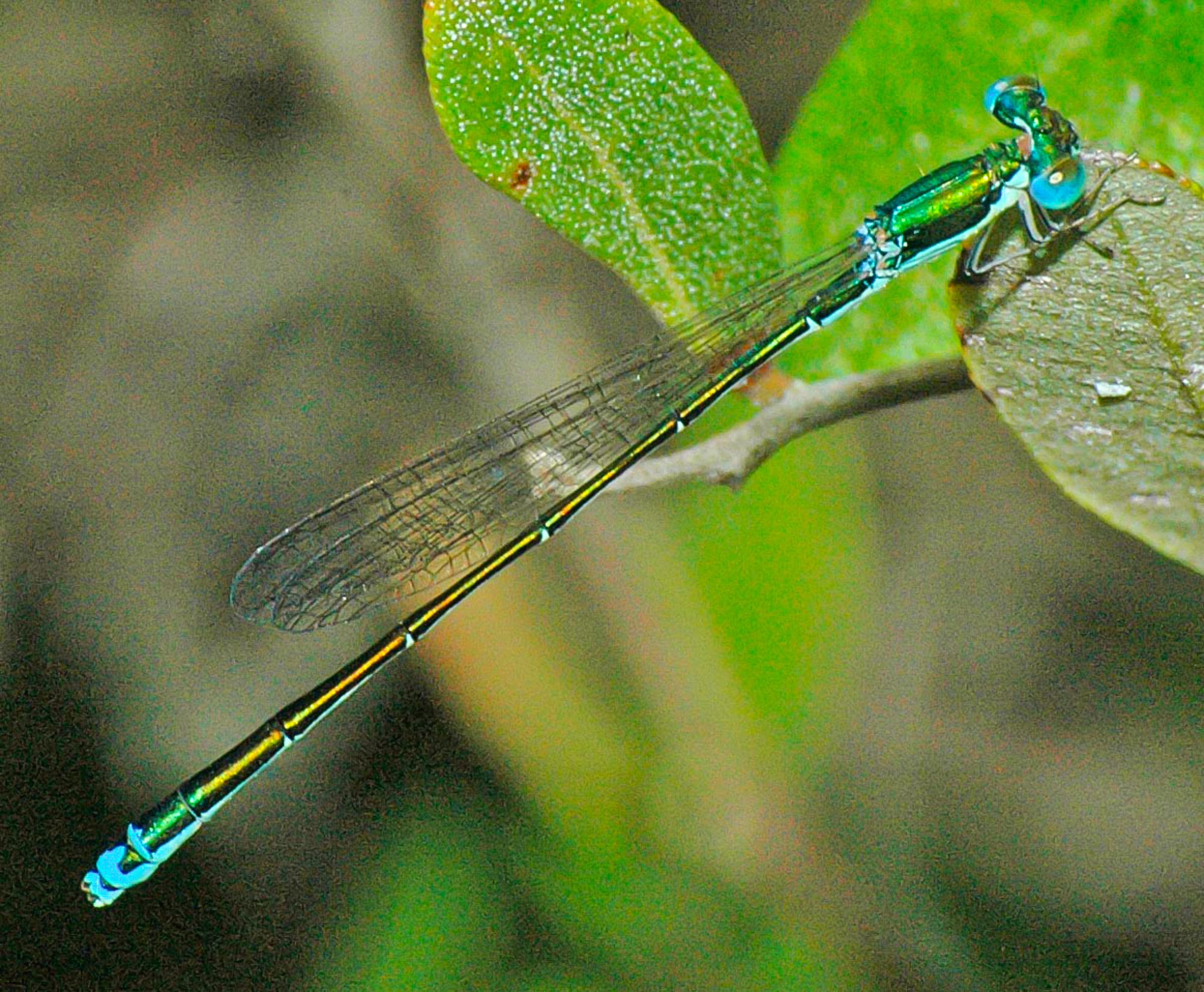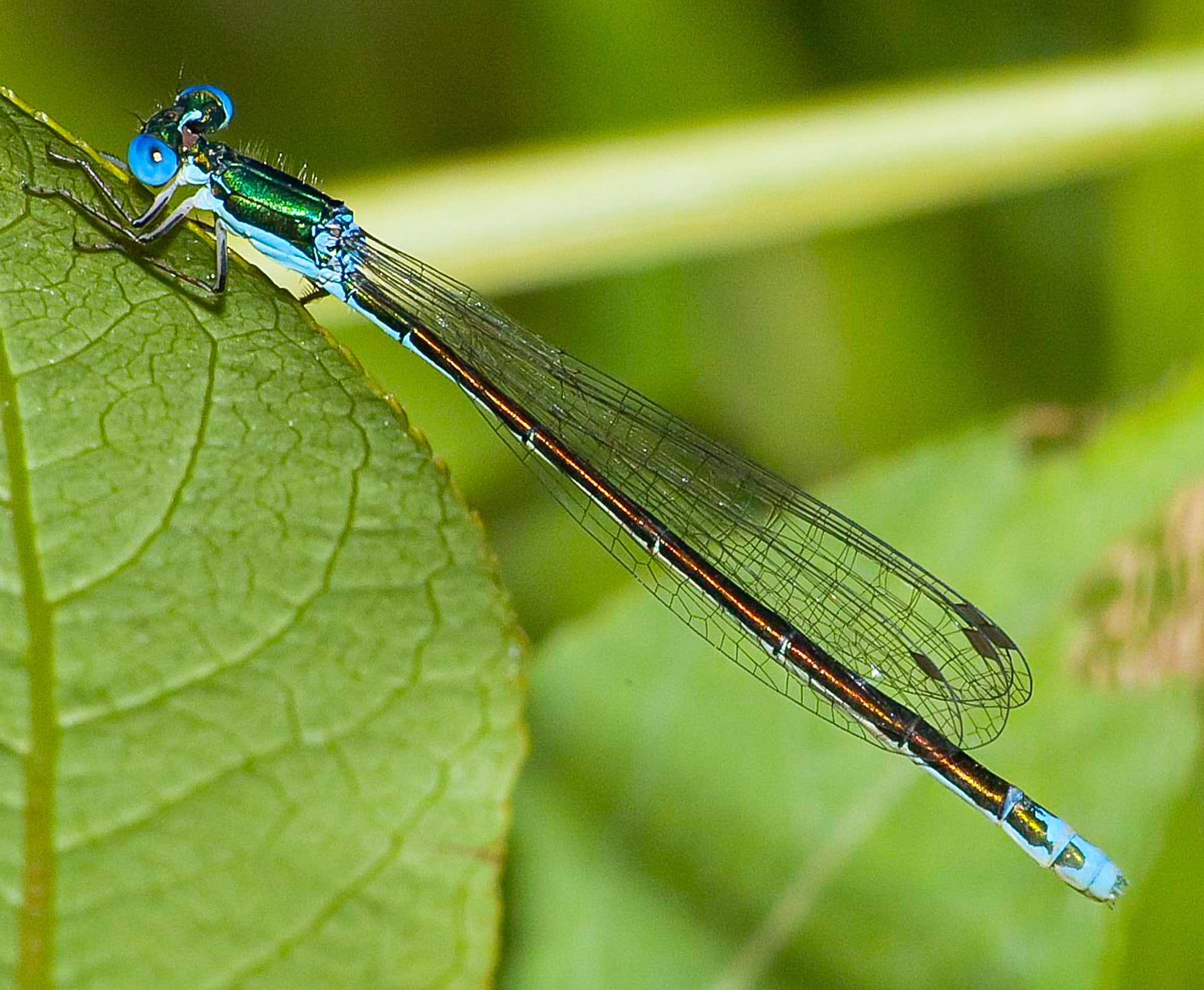Damselflies of the Methow Valley
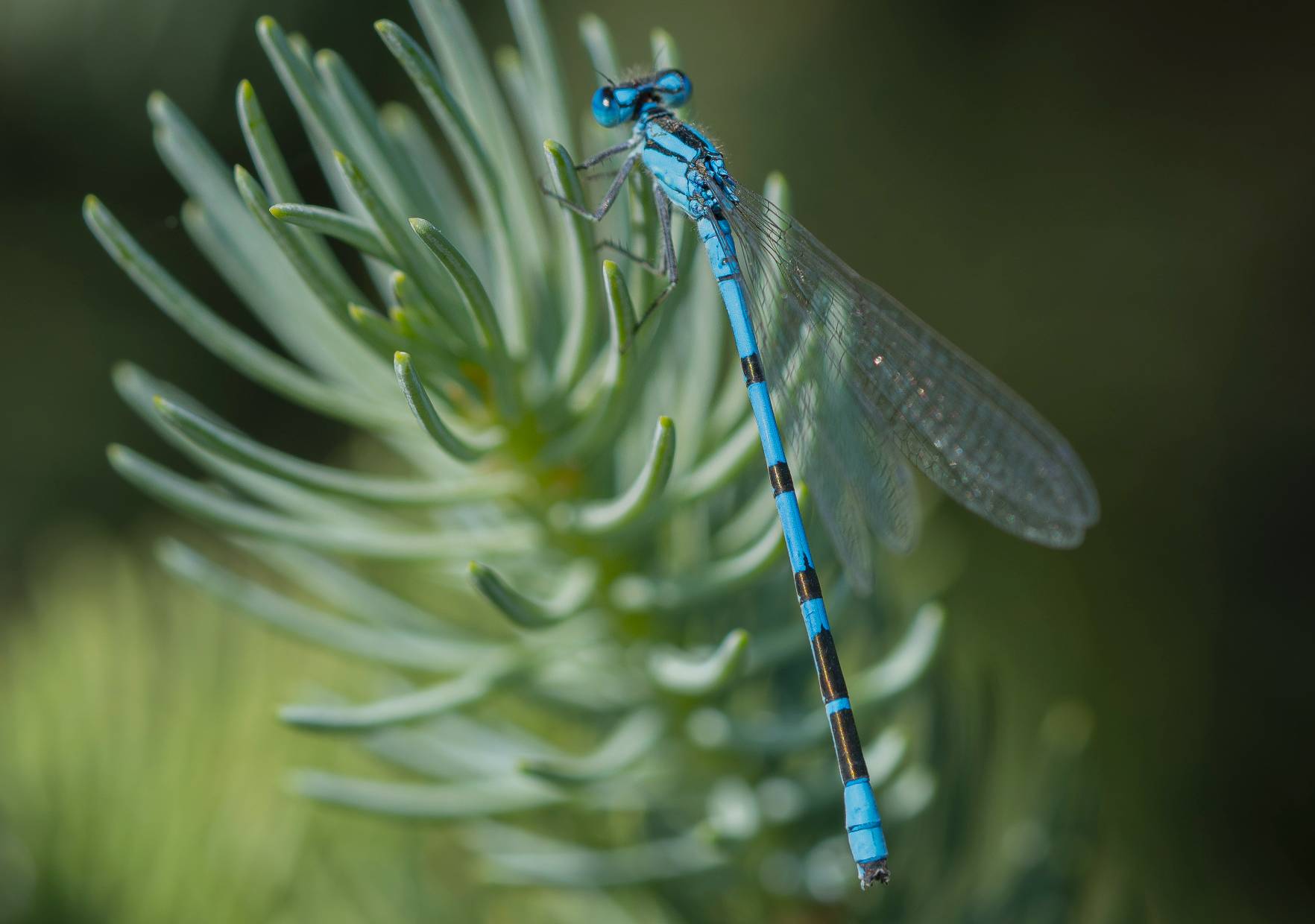
From late spring into early autumn, damselflies can be easily observed in the Methow Valley. These dainty insects are beautiful and fun to watch, but they can also be challenging to identify. Males and females often look very different, and many females even have different color morphs.
However, with practice, the unique colors, patterns, habitats, and behaviors can be learned, and this guide is intended to help you identify the 14 species of damselflies that are known to occur in the Methow Valley (as of May 2024).
The species checklist, photos, and supporting details were generously donated to Methow Nature Notes by Dennis Paulson so we can all learn how to recognize these species and contribute our sightings to the growing body of knowledge about damselfly seasonality and distribution in Washington. I have drawn from a range of references to add helpful field marks to the photos and write a description for each species.
There are currently two fantastic field guides that can help you learn more about damselflies of the Pacific Northwest, along with many more details than I can provide here. One is Dennis Paulson's classic Dragonflies and Damselflies of the West, and other is the newly published Dragonflies and Damselflies of Oregon by Cary Kerst & Steve Gordon.
You'll notice that the colors of a damselfly's ten abdominal segments (S1-10), and occasionally the shape of a damselfly's appendages, are some of the most important field marks. Pay close attention to these features and you'll have a much better chance of being sure of your identification.

Have fun watching damselflies!
SPOTTED SPREADWING Lestes congener
Common around lakes and ponds up to 5800 feet. Prefers areas with abundant vegetation and may be the only spreadwing found around larger bodies of water with cattails and bulrushes. Often strays from water to roost in nearby trees or tall shrubs.
Can be found from May 30 to December 1, and is the last damselfly to continue flying in the autumn.
Identification:
Both sexes have dark thorax with pale brown narrow stripe, and 2-4 elongated dark spots underneath the thorax (best seen from below, but partially visible in a side view). Thorax shows two abrupt "steps" between sharply contrasting dark and light patches. Abdomen is a dark metallic brown.
Male has blue eyes and pruinose tip on abdomen.
Female has two-toned brown eyes.
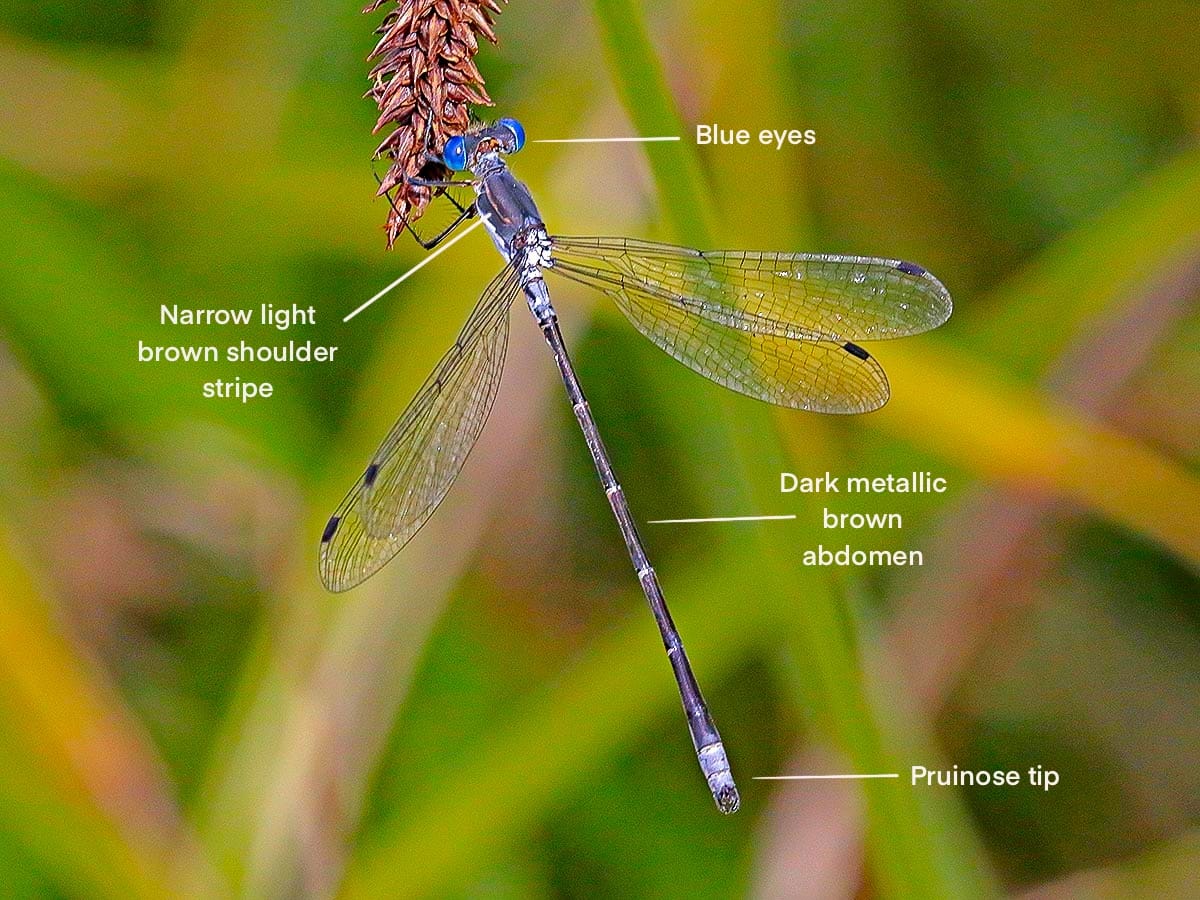
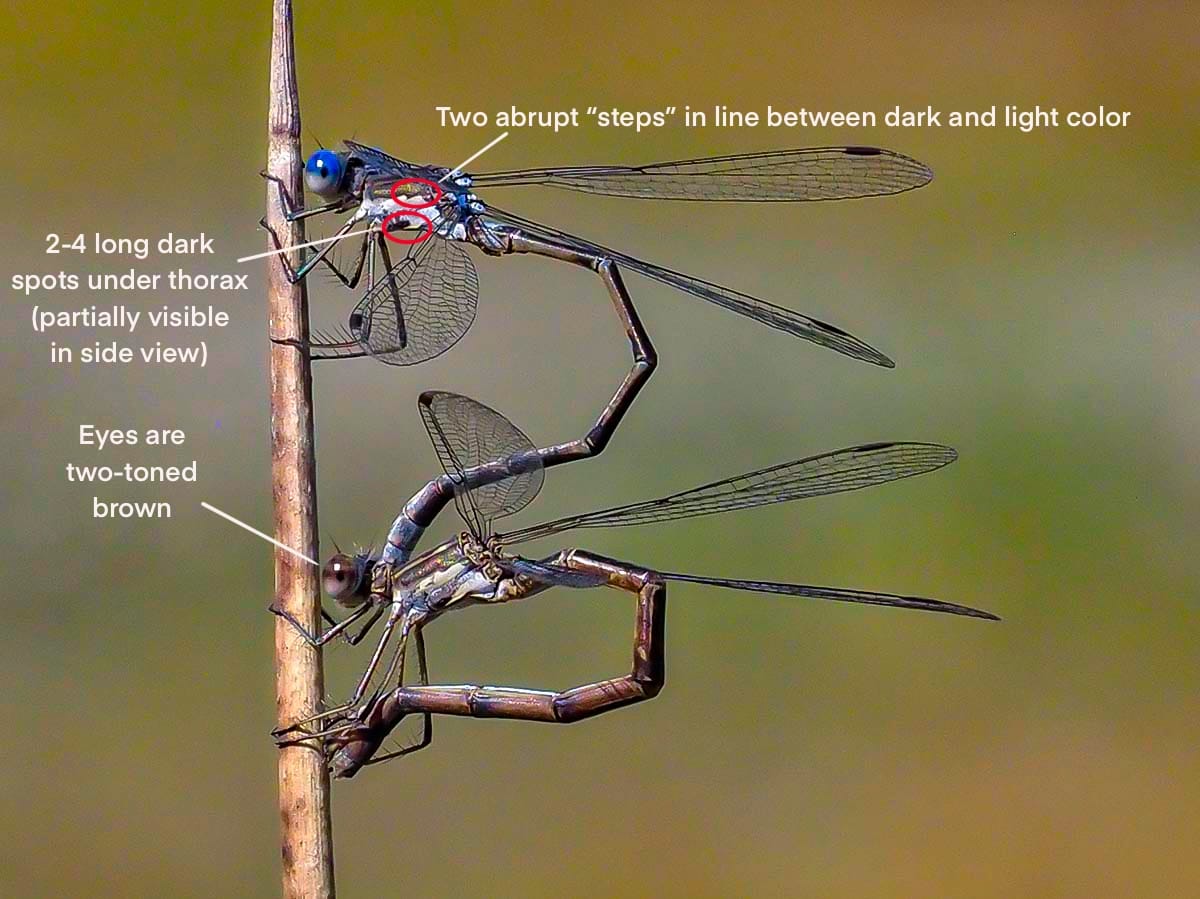
NORTHERN SPREADWING Lestes disjunctus
Common around lakes, ponds, and boggy areas up to 5800 feet. Males favor dense emergent vegetation and spend most of their time close to water surface. Females and mated pairs mainly observed at midday, with pairs landing on live or dead plant stems of rush and sedges to lay eggs inside plant tissues. Pairs often crawl underwater to lay eggs, coming up periodically for air.
Found from June 23 to October 21.
Identification:
Male thorax is pruinose with very dark blue to blackish stripes. First 2 and last 3 abdominal segments are pruinose.
Female can be brown or blue like a male. Eyes blue or brown. Thorax has a wide dark stripe that widens towards rear, and a light side stripe that narrows towards rear. Top of abdomen is dark brown.


EMERALD SPREADWING Lestes dryas
Occurs at scattered locations in valleys but more common in mountains up to 5800 feet in habitats ranging from sagebrush steppe to boreal forest. Favors temporary ponds with dense marsh vegetation but can be very common in shrublands or forested areas adjacent to breeding ponds. Often lays eggs in stems of rushes and sedges over dry land rather than over water.
Found from May 14 to September 29.
Identification:
Both sexes have a metallic green or copper appearance.
Male, first two and last three segments on abdomen are blue.
Female has very thin pale stripes on thorax.
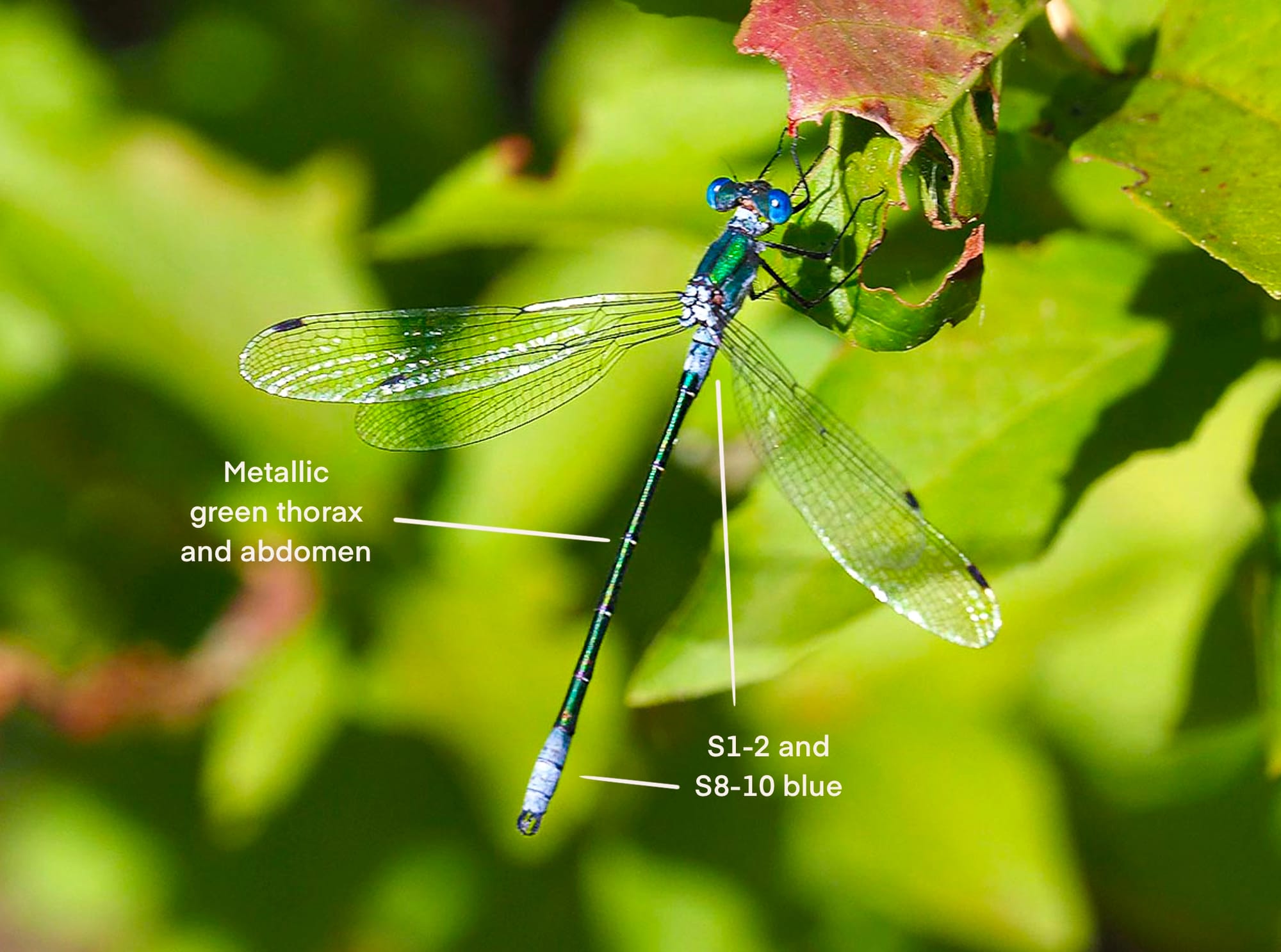
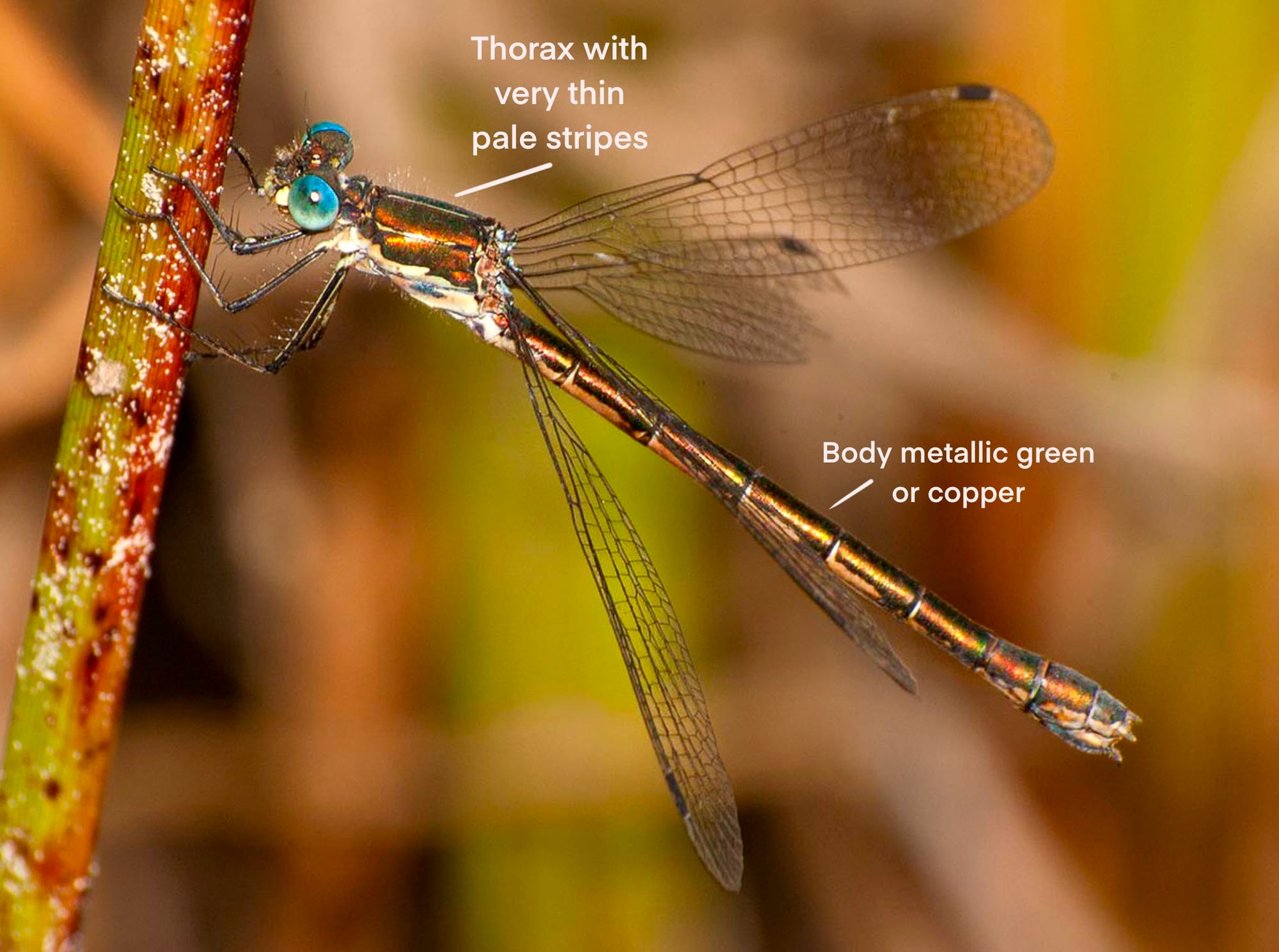
SWEETFLAG SPREADWING Lestes forcipatus
Occurs at scattered locations over a wide range from 1800-4650 feet. Lives around marshy and well-vegetated ponds or wetlands. Lays eggs in stems or rushes and sedges close to the water surface.
Found from July 12 to September 24.
Identification:
Both sexes are very similar to several other spreadwings and may require in-hand examination to accurately identify.
Male is best identified by looking at the second segment of the abdomen, which is blue on forward 2/3 and dark on the rear 1/3. Appendages at the tip of the male's abdomen (holding the female's head, and hidden, in this photo) are long, with the distal tooth (marked with an arrow) being small and blunt (large and sharply pointed in northern spreadwing above).
Female's ovipositor is uniquely large, extending beyond tip of abdomen.
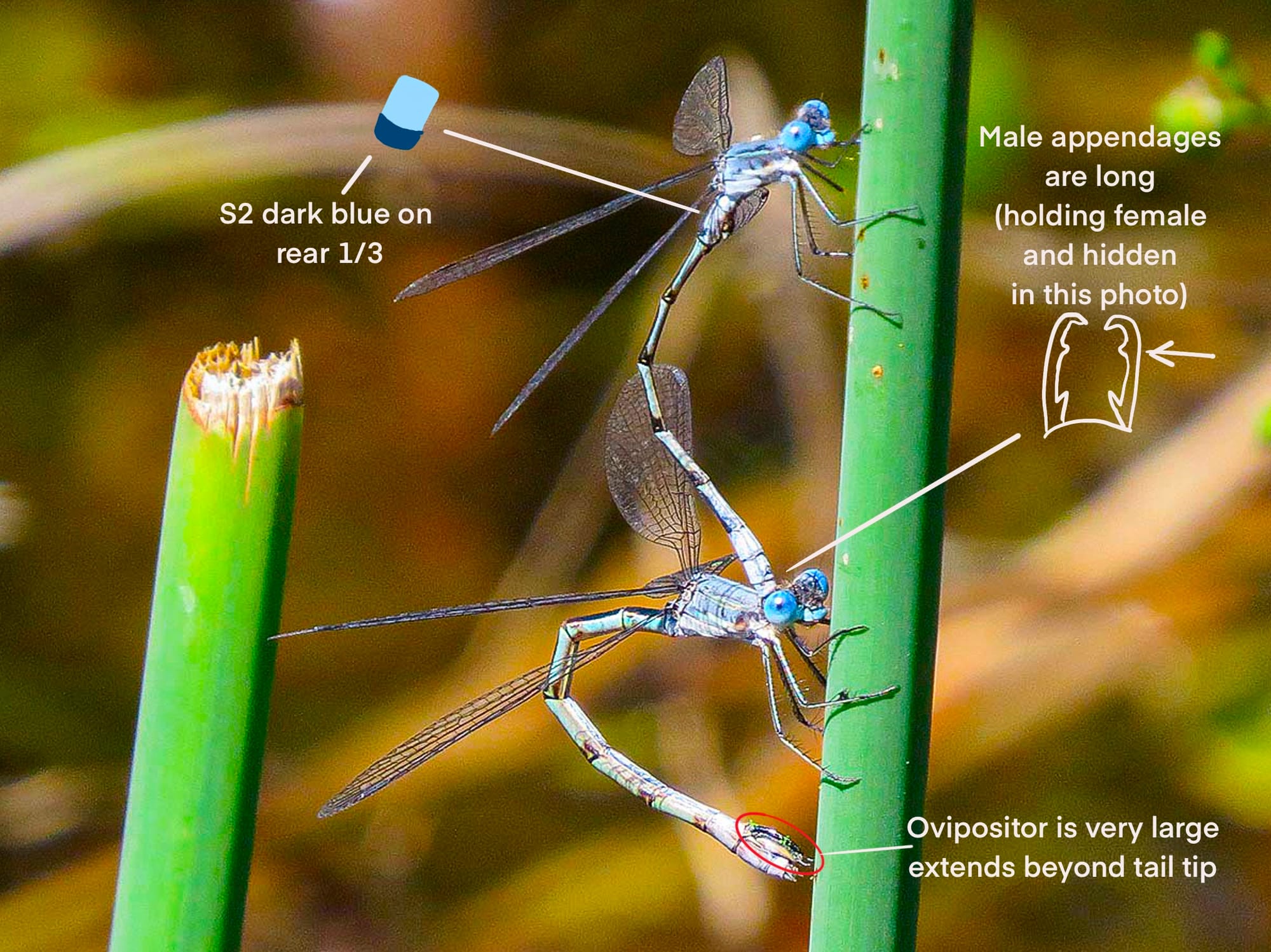
LYRE-TIPPED SPREADWING Lestes unguiculatus
Mostly found at lower elevations but rarely up to 6500 feet. Favors ponds, especially temporary ponds, with dense marsh vegetation.
Found May 25 to September 14.
Identification:
Both sexes have coppery bronze to metallic green thorax and metallic green abdomen. Thorax has pale green side stripe (wider in female). Colored cell on leading edge of wing (pterostigma) can be white, or light brown with pale edges.
Male has unique lyre-shaped appendages at tip of abdomen.
Female abdomen is pale green below.
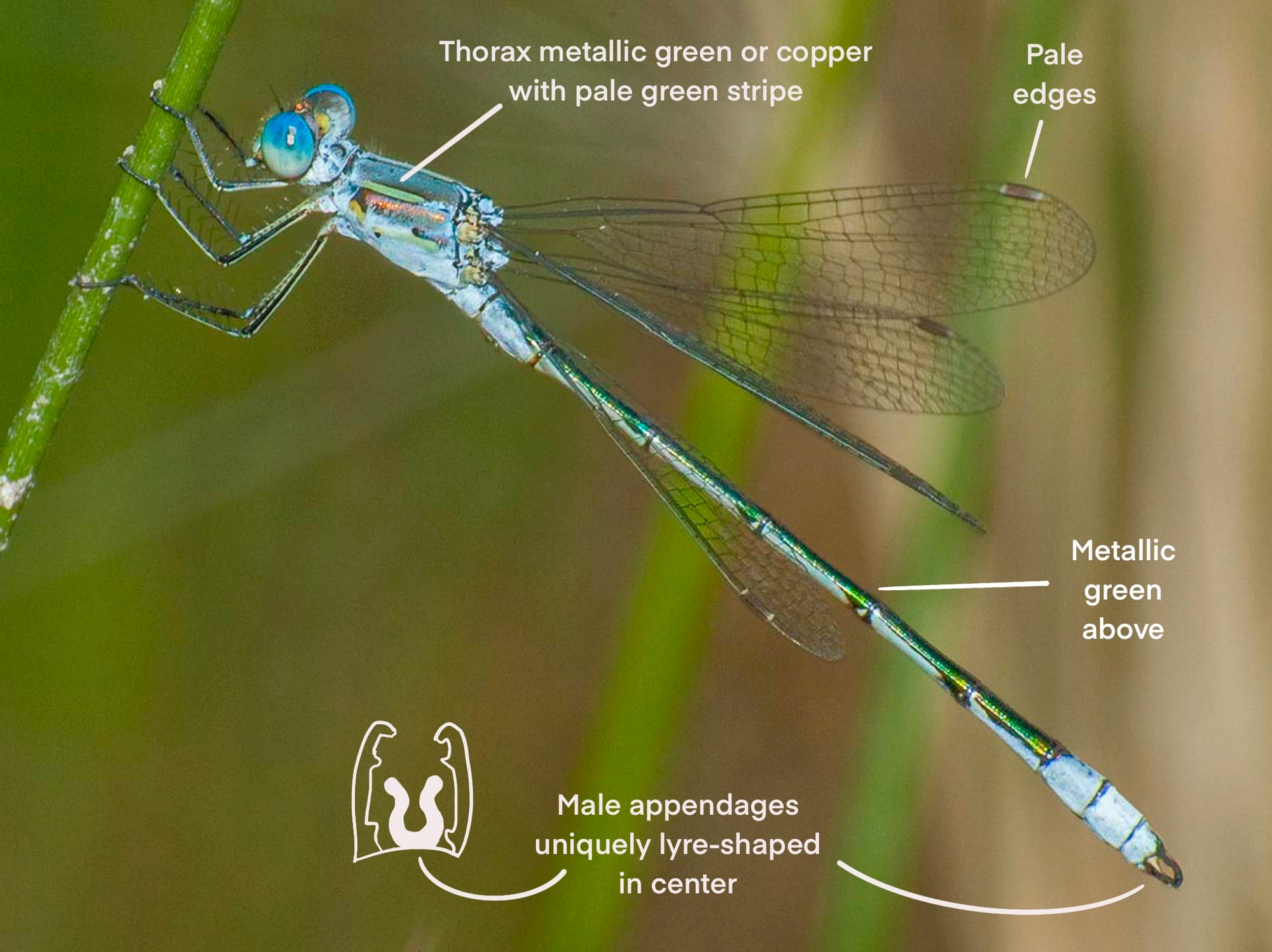
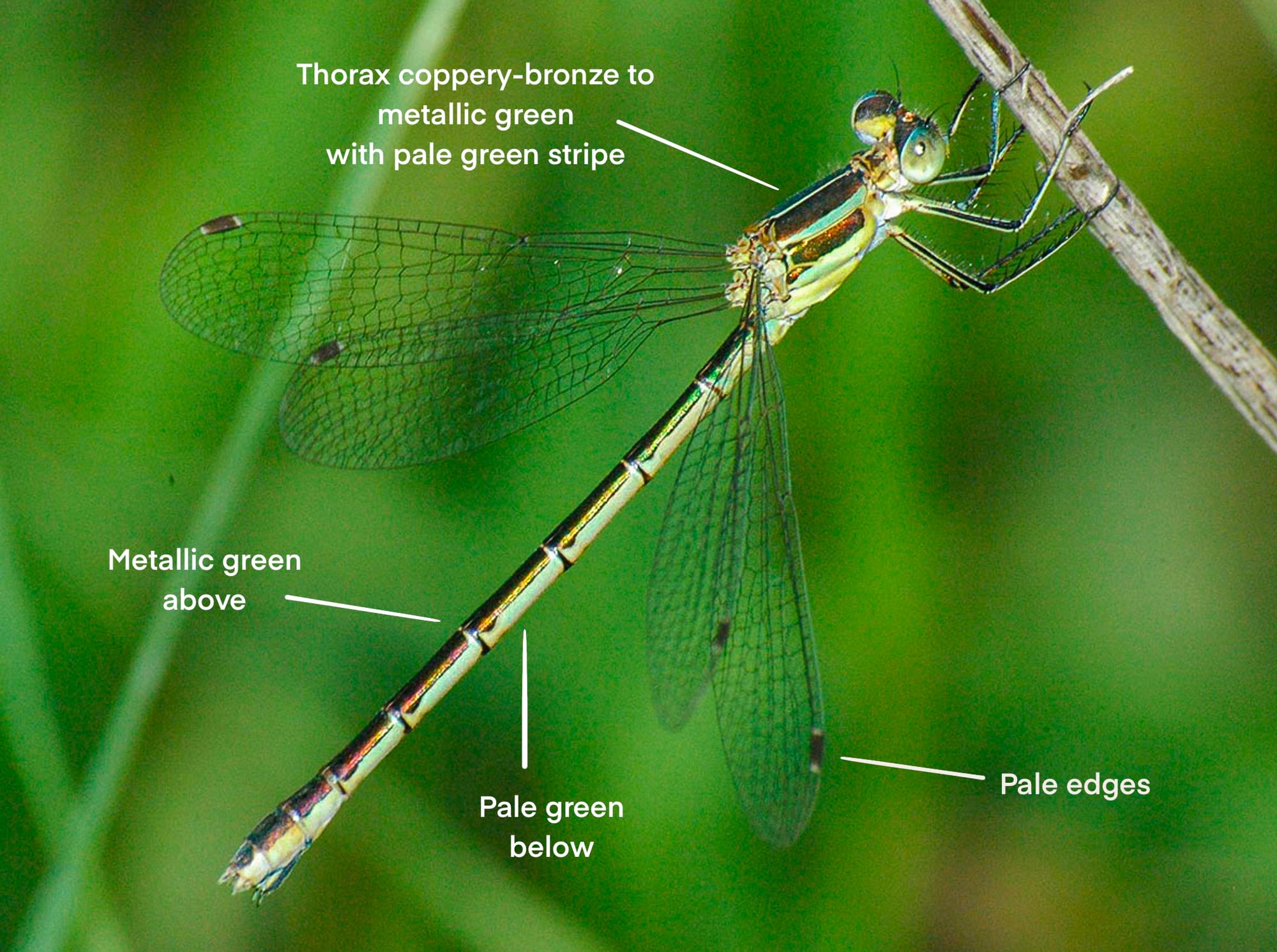
WESTERN RED DAMSEL Amphiagrion abbreviatum
Occurs in small, scattered populations up to 4400 feet. Lives in dense sedges at edges of ponds and slow waters, often around bogs or wet meadows with springs and wet ground. Fast fliers that often remain hidden in low, dense vegetation, best seen at midday when pairs make an appearance.
Found from April 27 to September 22, generally more common earlier in the season.
Identification:
Both sexes show much red. A small damselfly with a short abdomen that barely extends beyond tip of folded wings.
Male is bright red. Head is dark above, and the conspicuously hairy thorax is black on top.
Female is red-orange, light orange, or dull brown.
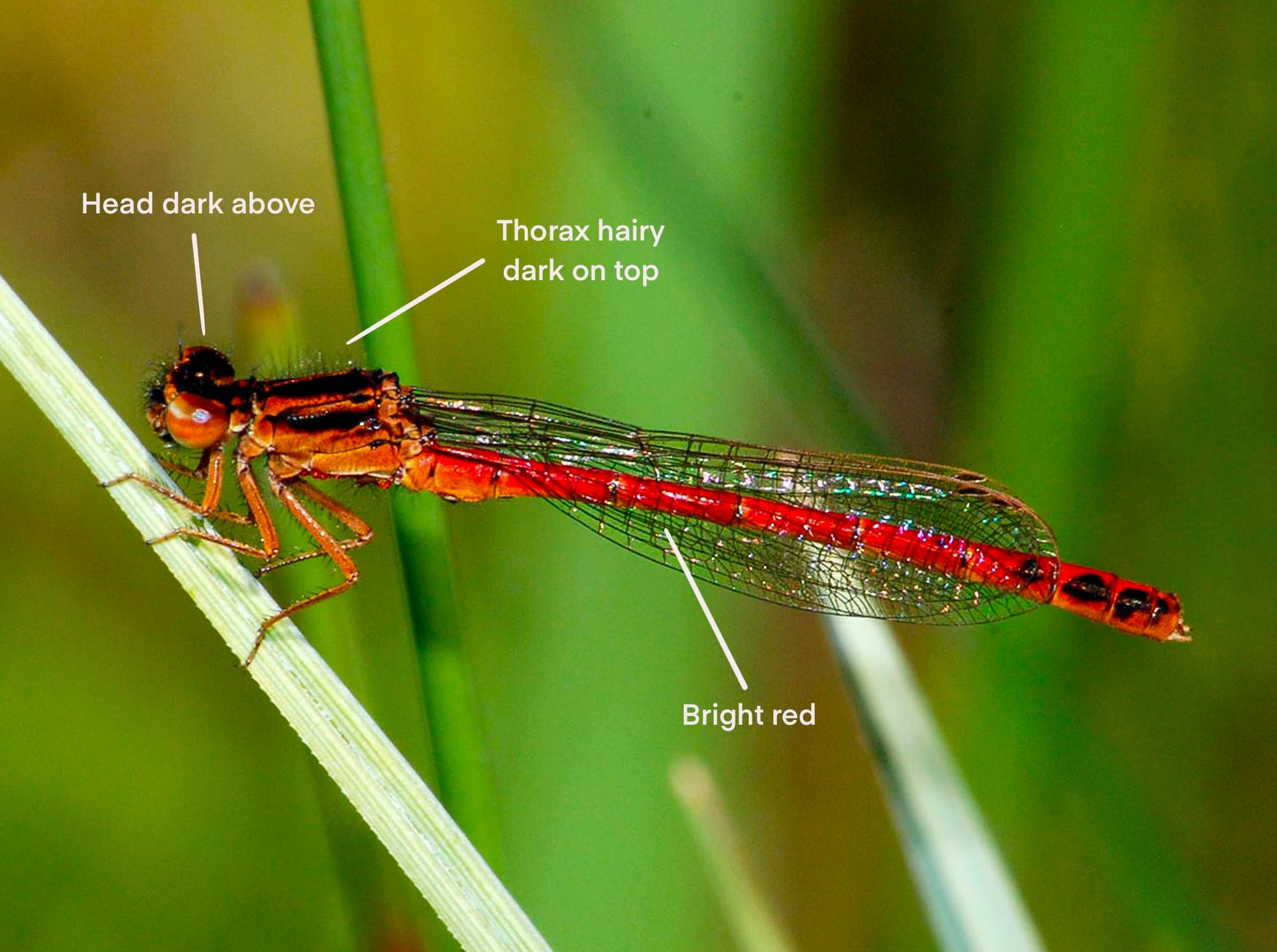
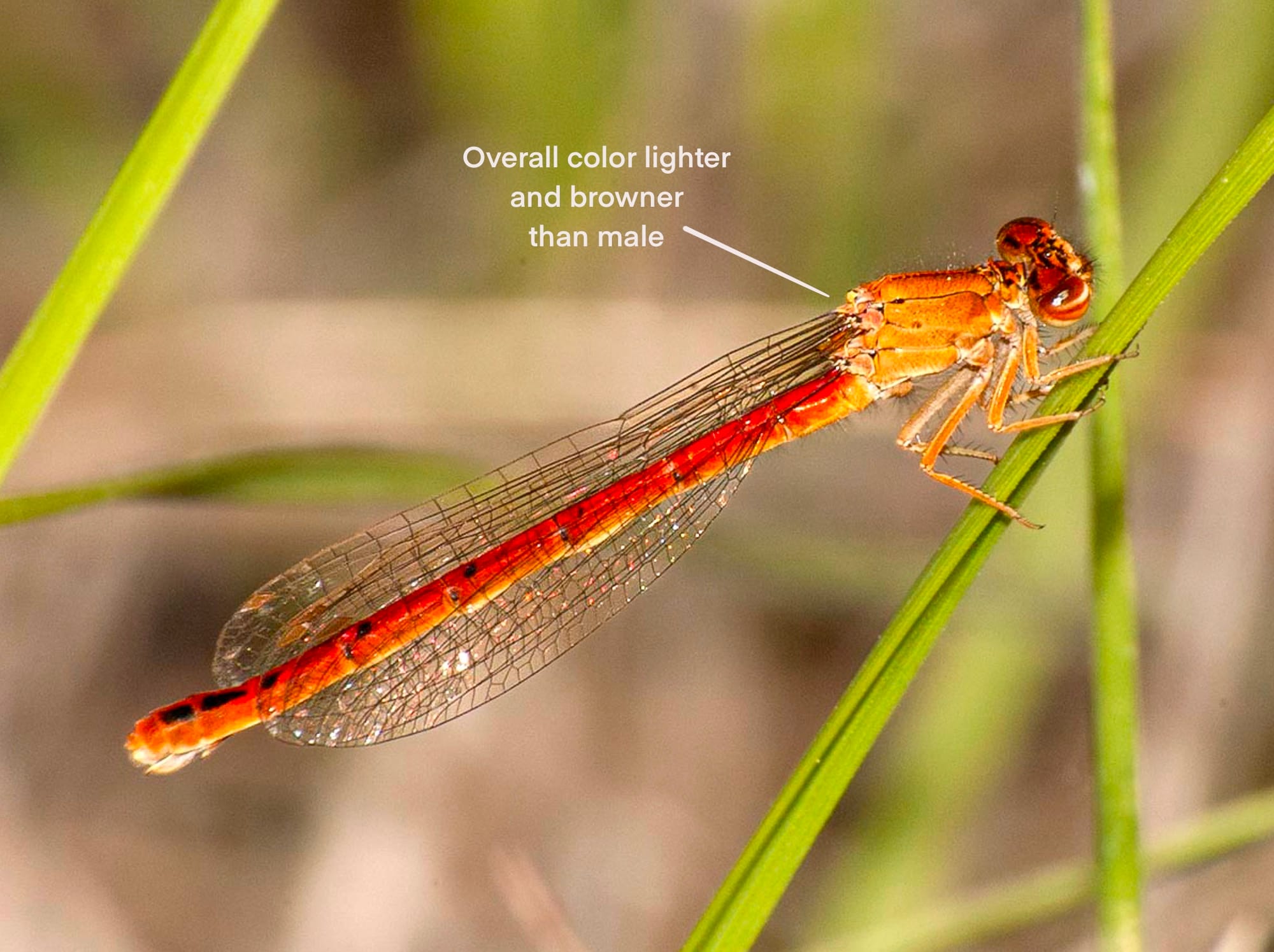
VIVID DANCER Argia vivida
Common at lower elevations up to 2100 feet. Prefers seeps, springs, and small streams, where it perches on plants, logs, rocks, or the ground near water. Courtship and mating occur away from water, but pairs return to water at midday to lay eggs.
Found from March 17 to October 22.
Identification:
Both sexes hold folded wings above body at rest. Have dark, narrow, arrow-shaped marks on sides of abdomen, and dark side stripe on thorax narrows in the middle.
Male is a startingly bright blue damselfly. Last three segments on abdomen are a lighter shade of blue.
Female patterned like male, but overall color can be blue, lavender, brown, or white.
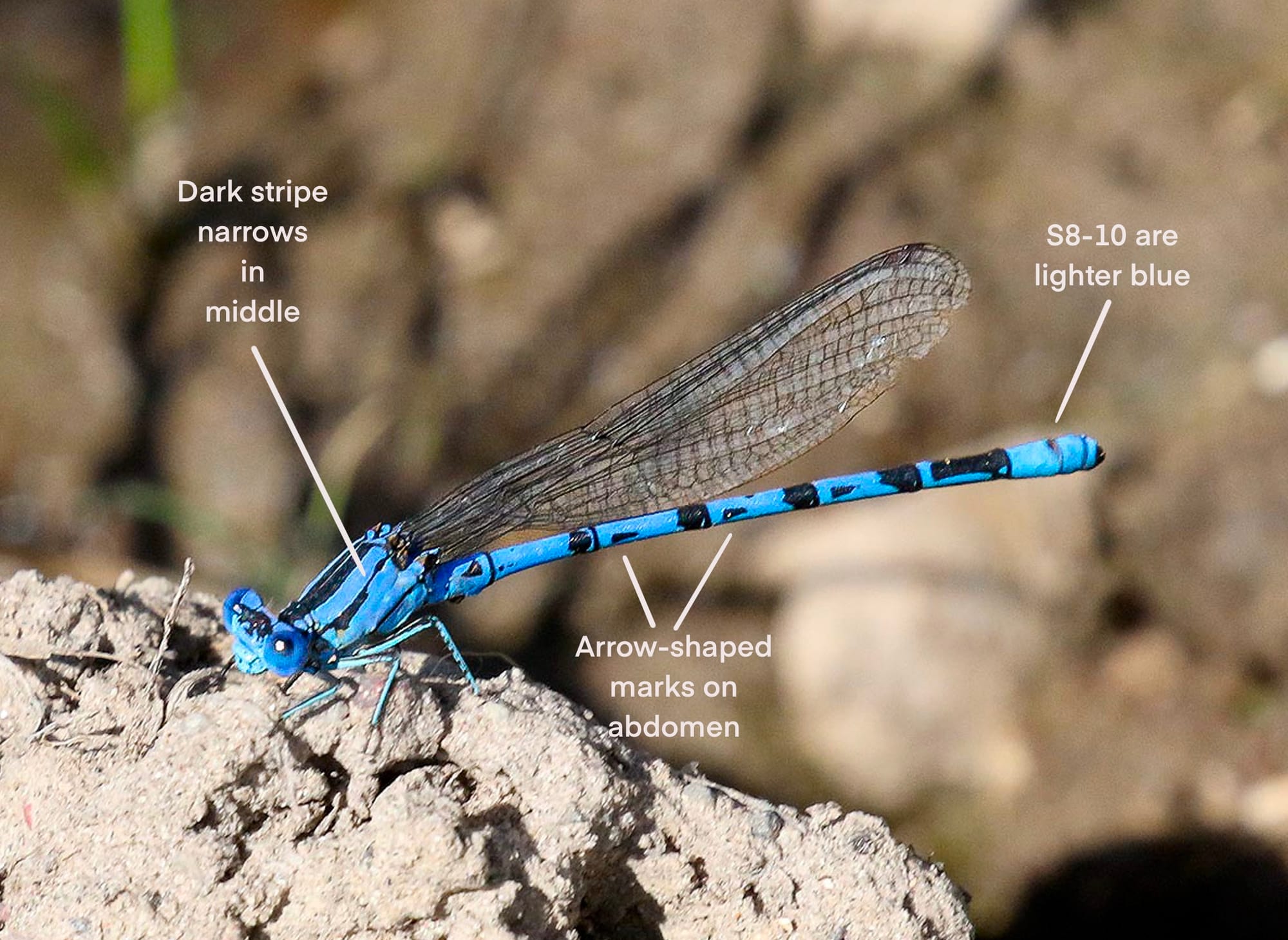
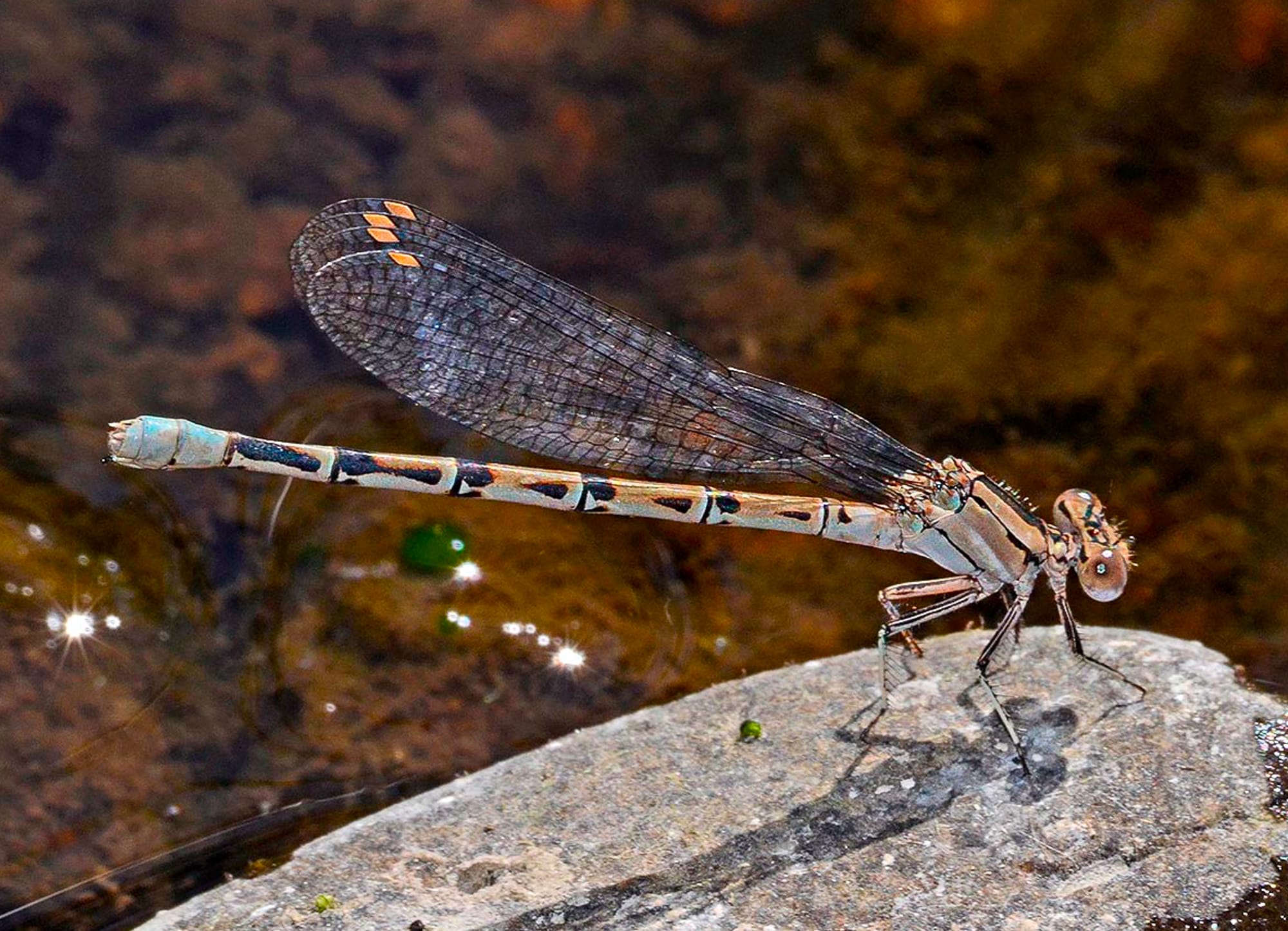
TAIGA BLUET Coenagrion resolutum
Damselfly of Alaska and Canada that occurs at higher elevations in Washington. Favors well-vegetated ponds and lakes edges from 2000-5700 feet, sticking to cooler shadier patches and remaining within dense sedges and emergent plants.
Found from May 10 to September 12.
Identification:
Bluets can be an extremely challenging group to identify, but this bluet is probably the easiest due to both sexes being almost entirely black on top of abdominal segments 6-7.
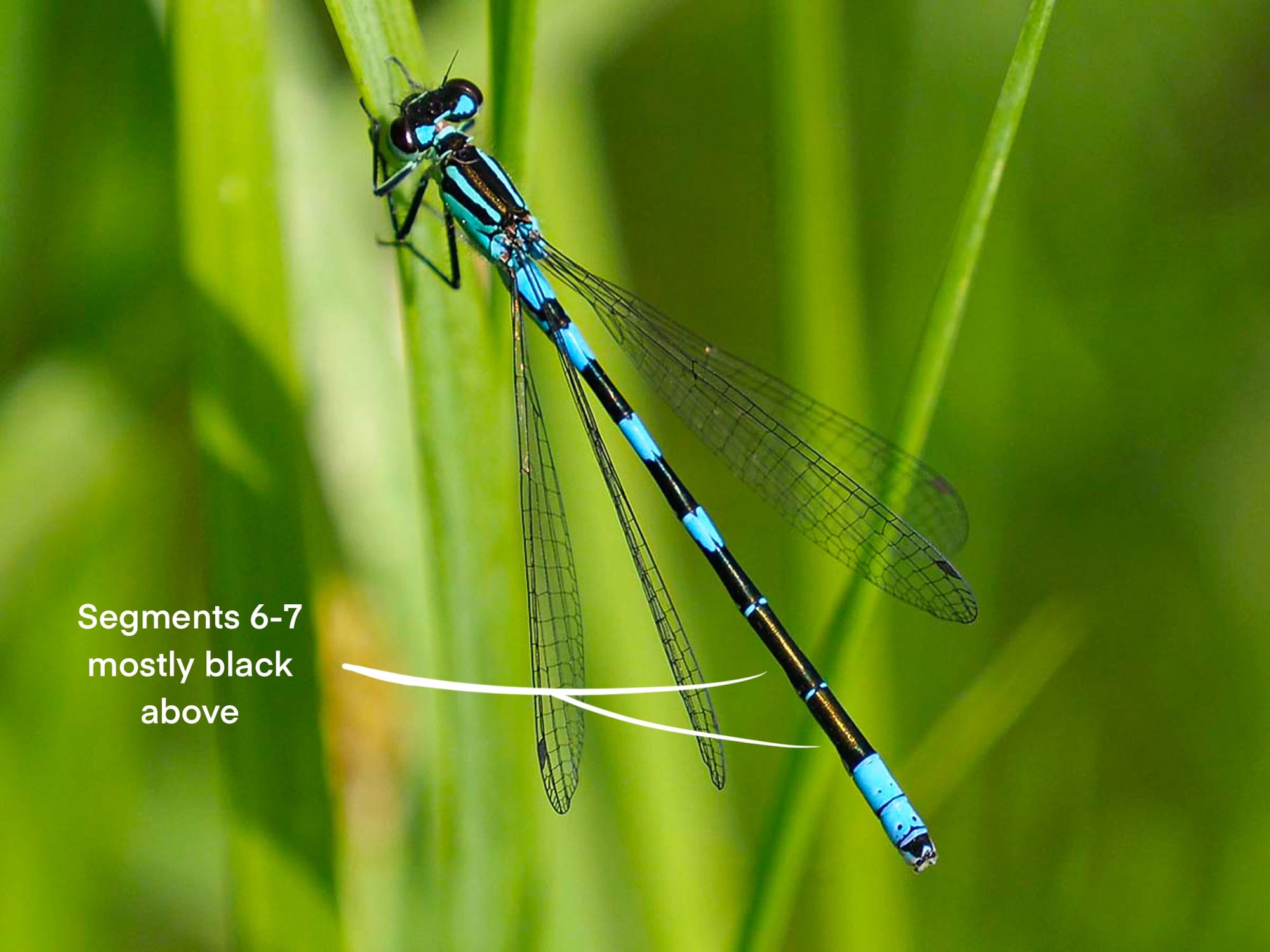
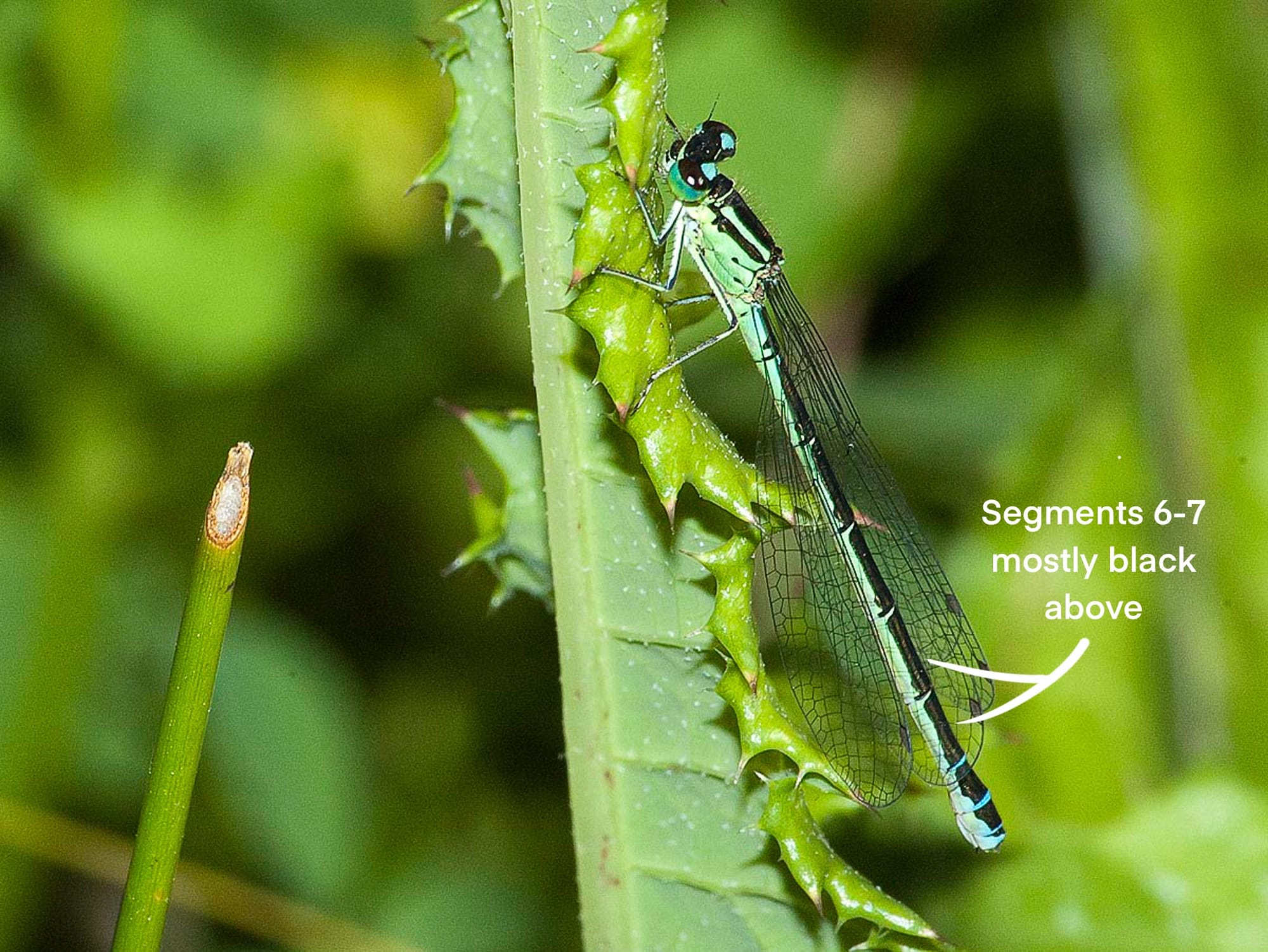
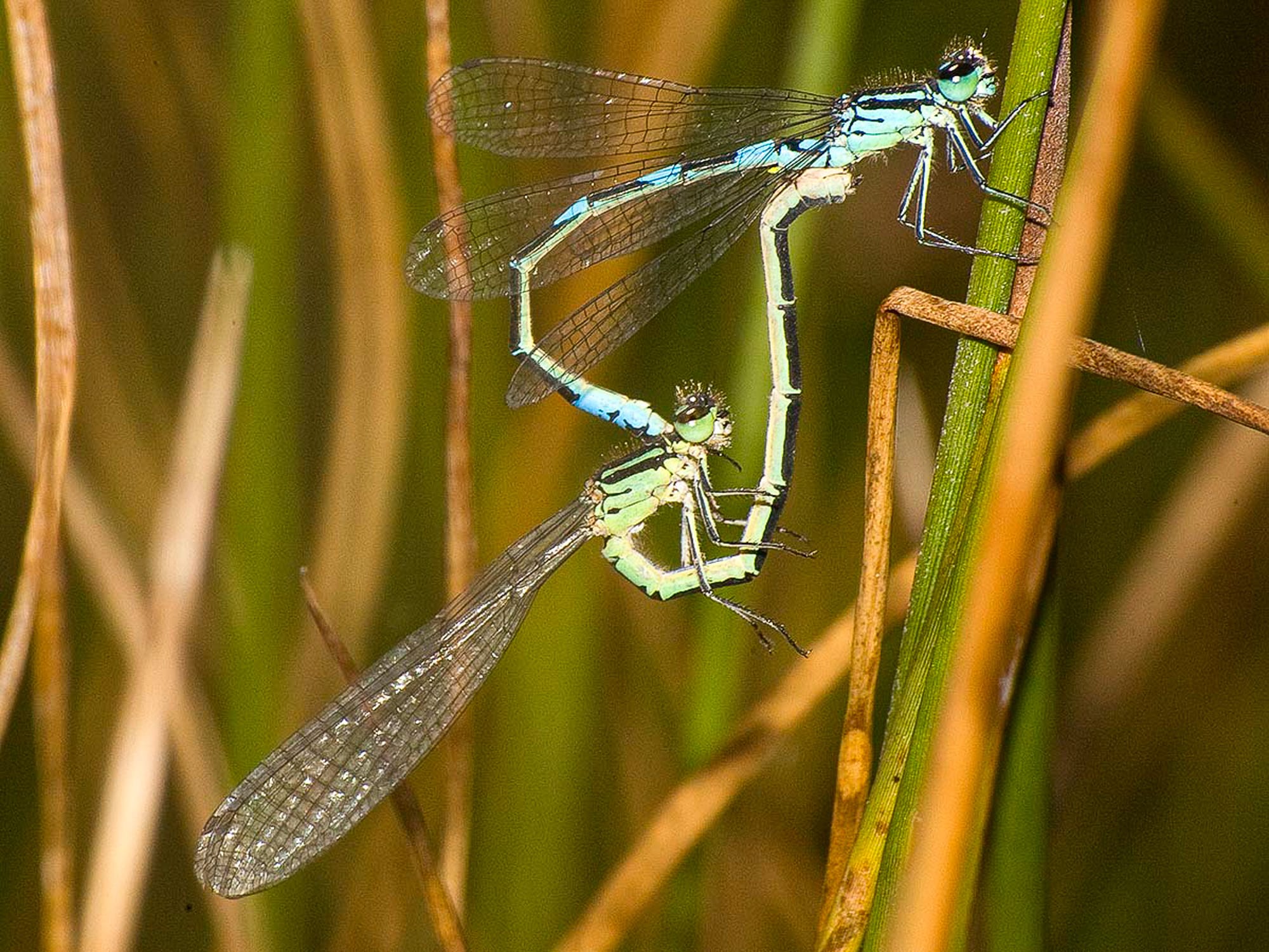
NORTHERN BLUET Enallagma annexum
Common up to 4550 feet around ponds, lakes, and slow streams. Males may be found perched on vegetation at the water's edge in great numbers. Pairs form in sunny clearings near water, then pairs fly to water to lay eggs on either floating or submerged vegetation (spending up to 90 minutes as much as 3 feet underwater).
Found from May 5 to November 2.
Identification:
Northern and boreal bluets (below) are so difficult to separate that even experts often lump them together as "NOBO" bluets. The only identifying field mark is a tiny hook on the appendage of the male northern, which is best seen in the hand.
Male has more blue than black on middle segments of abdomen.
Female has both blue and tan forms. Black patches on middle segments of abdomen are larger than on males.
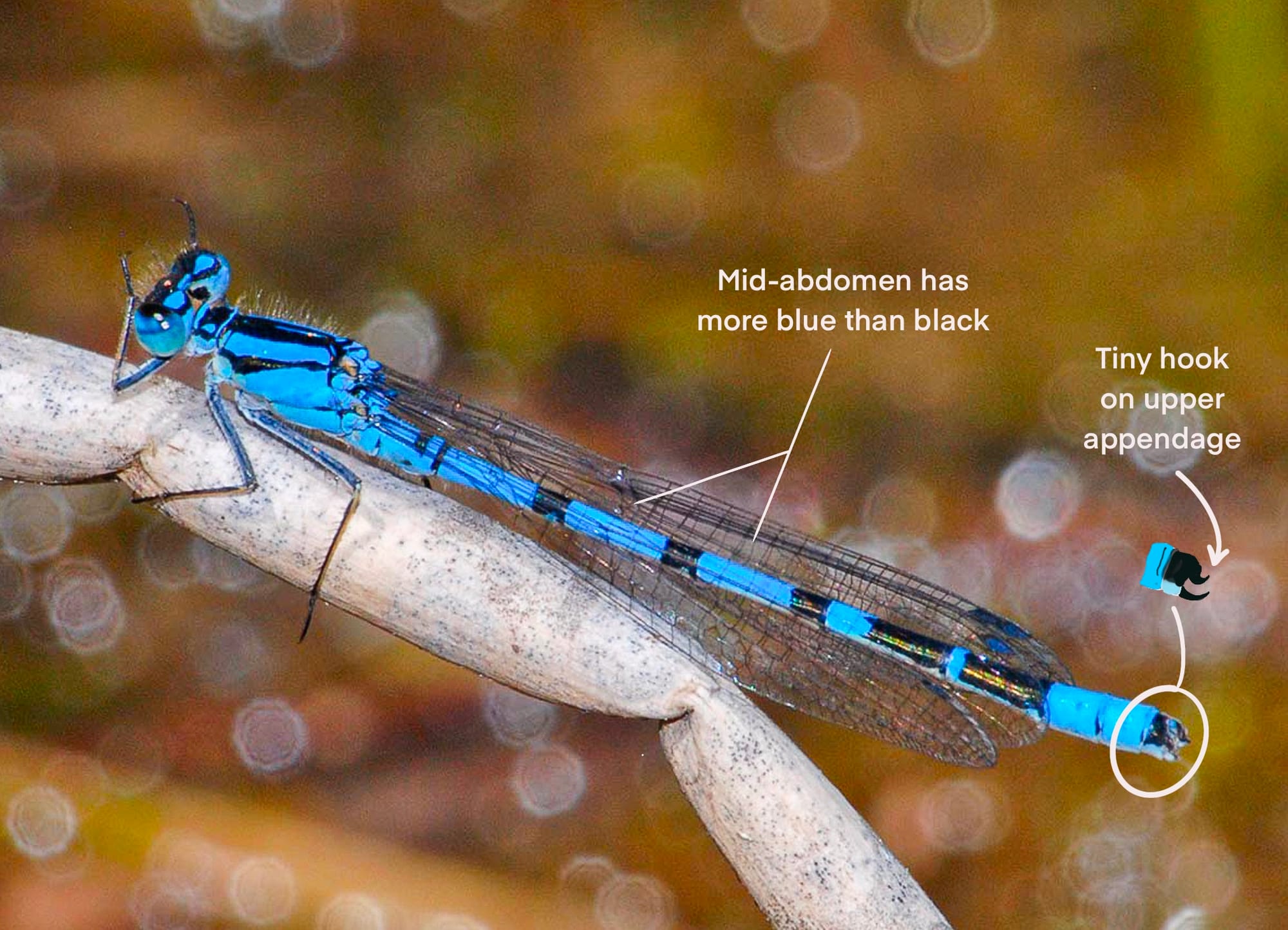
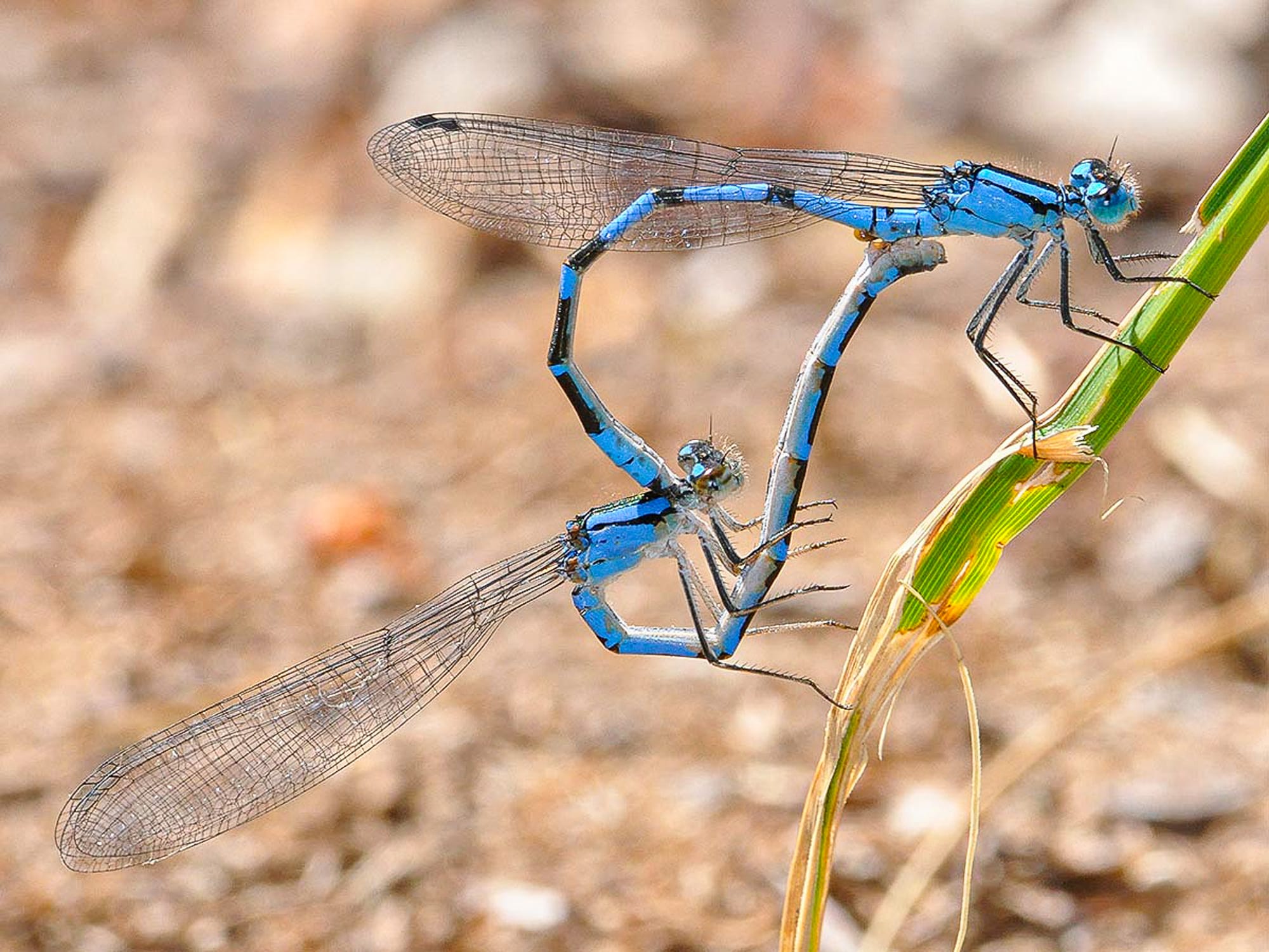
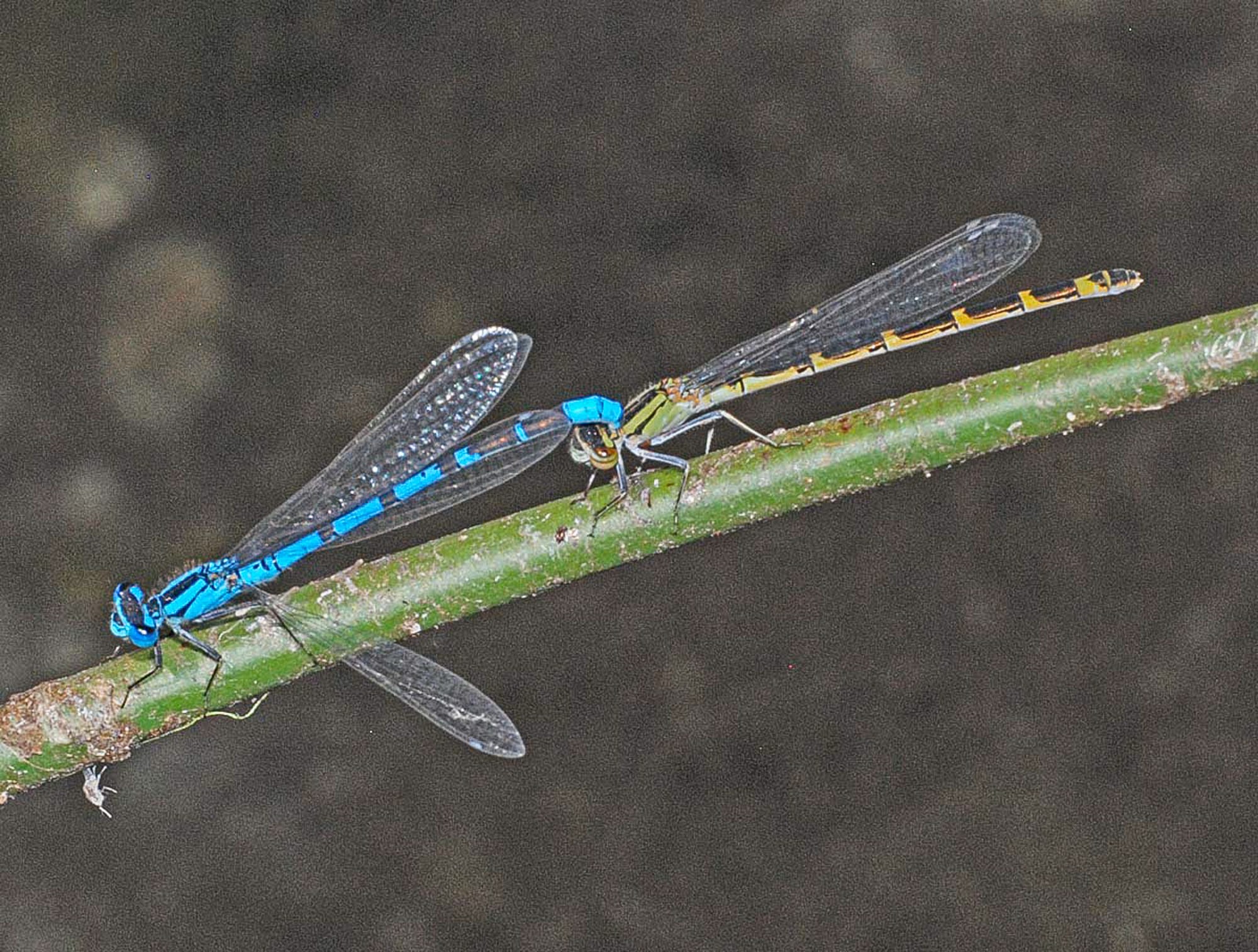
BOREAL BLUET Enallagma boreale
Common around lakes and ponds with emergent marsh vegetation up to 5800 feet. Males will fly over open water and perch on plants. Pairs can be extremely abundant in nearby open areas on land, returning to water to lay eggs on the water's surface.
Found April 11 to October 22.
Identification:
See Northern bluet above. Positive identification only possible by closely examining a male in the hand to see the blunt, rounded tip on the upper appendage at the end of the tail. [Based on this mark, I believe the featured photo at the top of the page is a boreal bluet.]
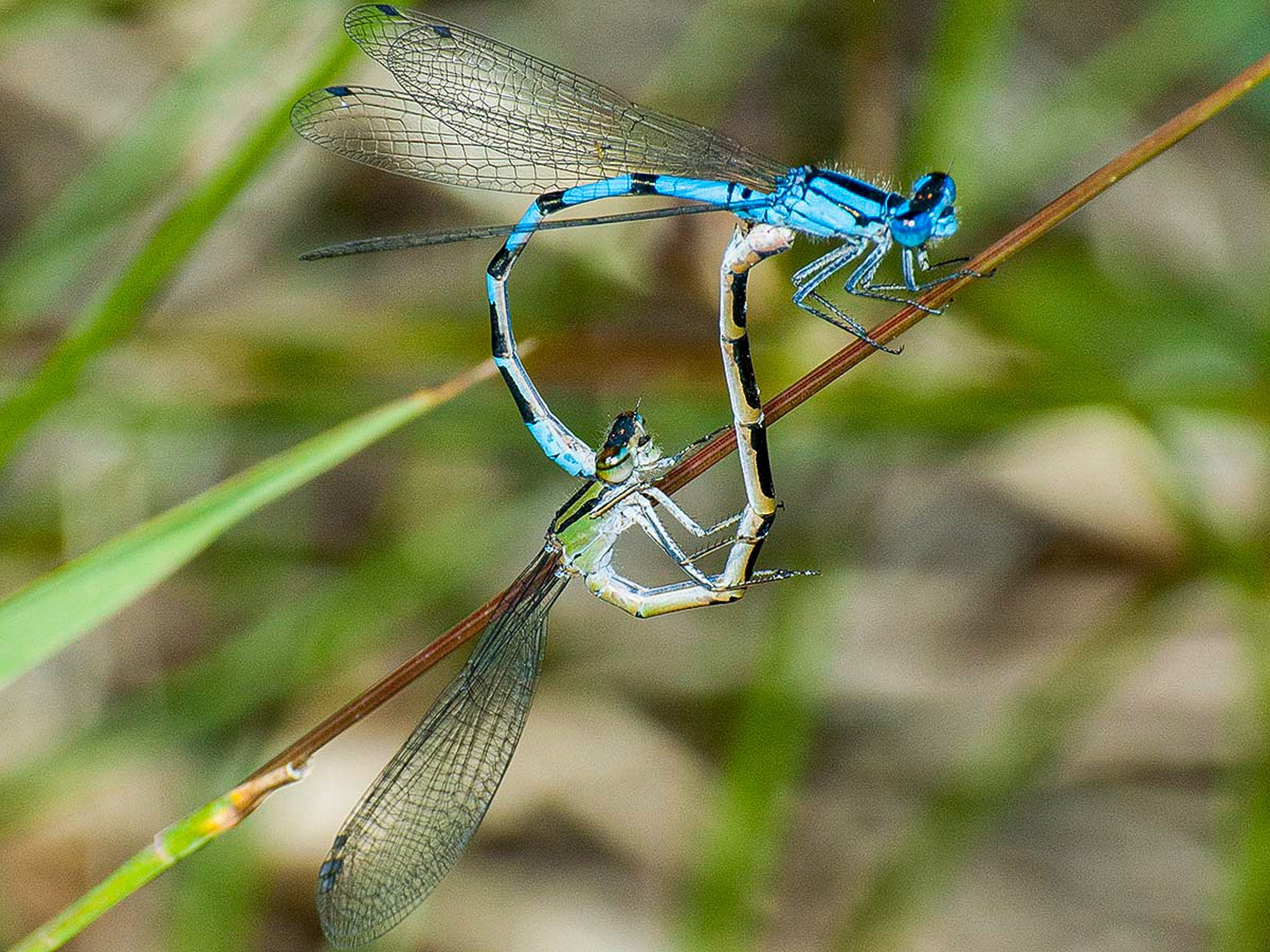
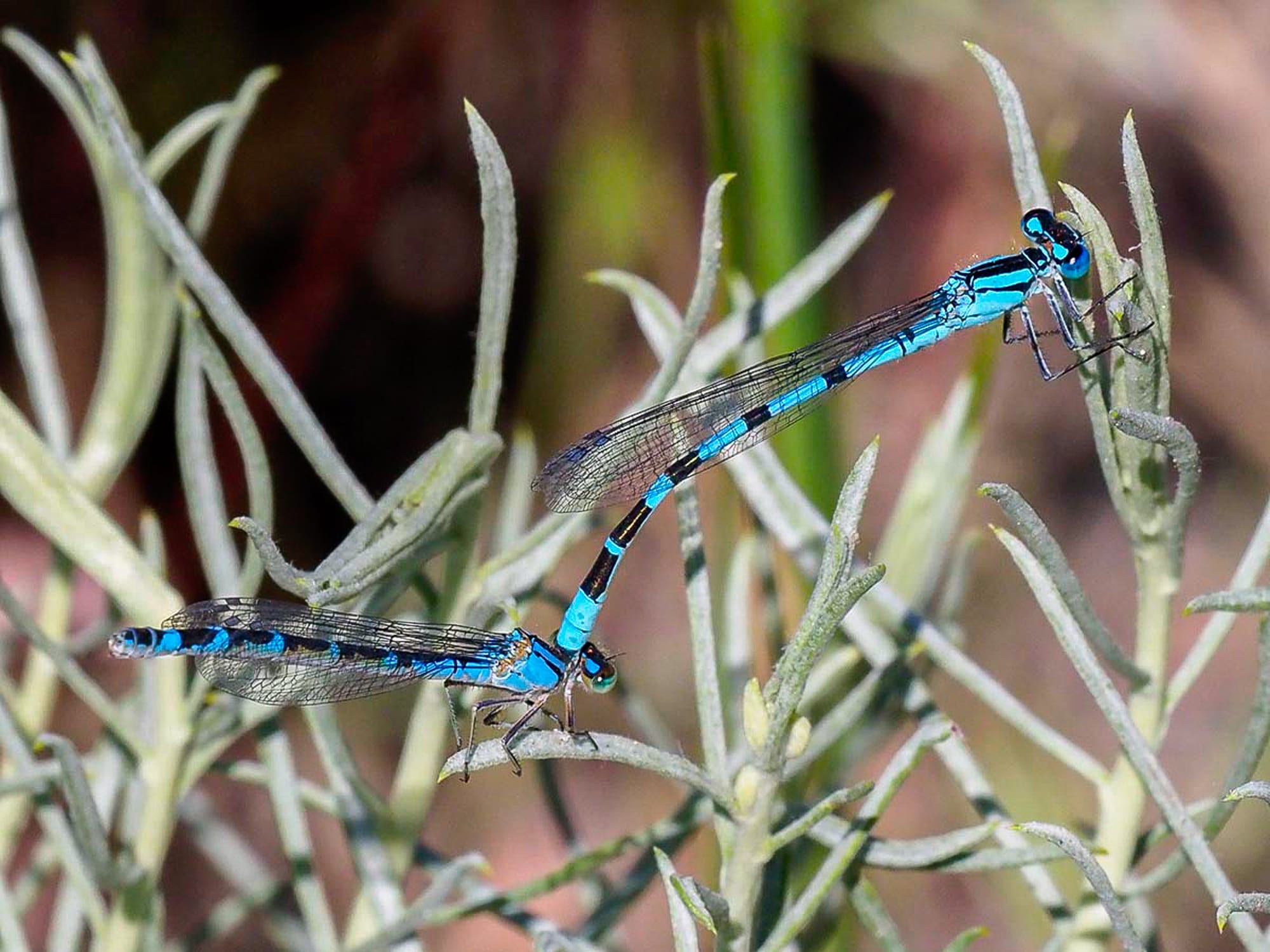
TULE BLUET Enallagma carunculatum
Common at ponds and lakes with marsh vegetation up to 2300 feet, may be particularly numerous around larger lakes with extensive stands of tall cattails. Often seen flying out over open water.
Found from April 17 to November 18
Identification:
Best sexes show more black on middle segments than other similar-looking bluets.
Male has a tiny white bump on upper appendage.
Female lacks blue on middle segments, has both blue and tan forms.
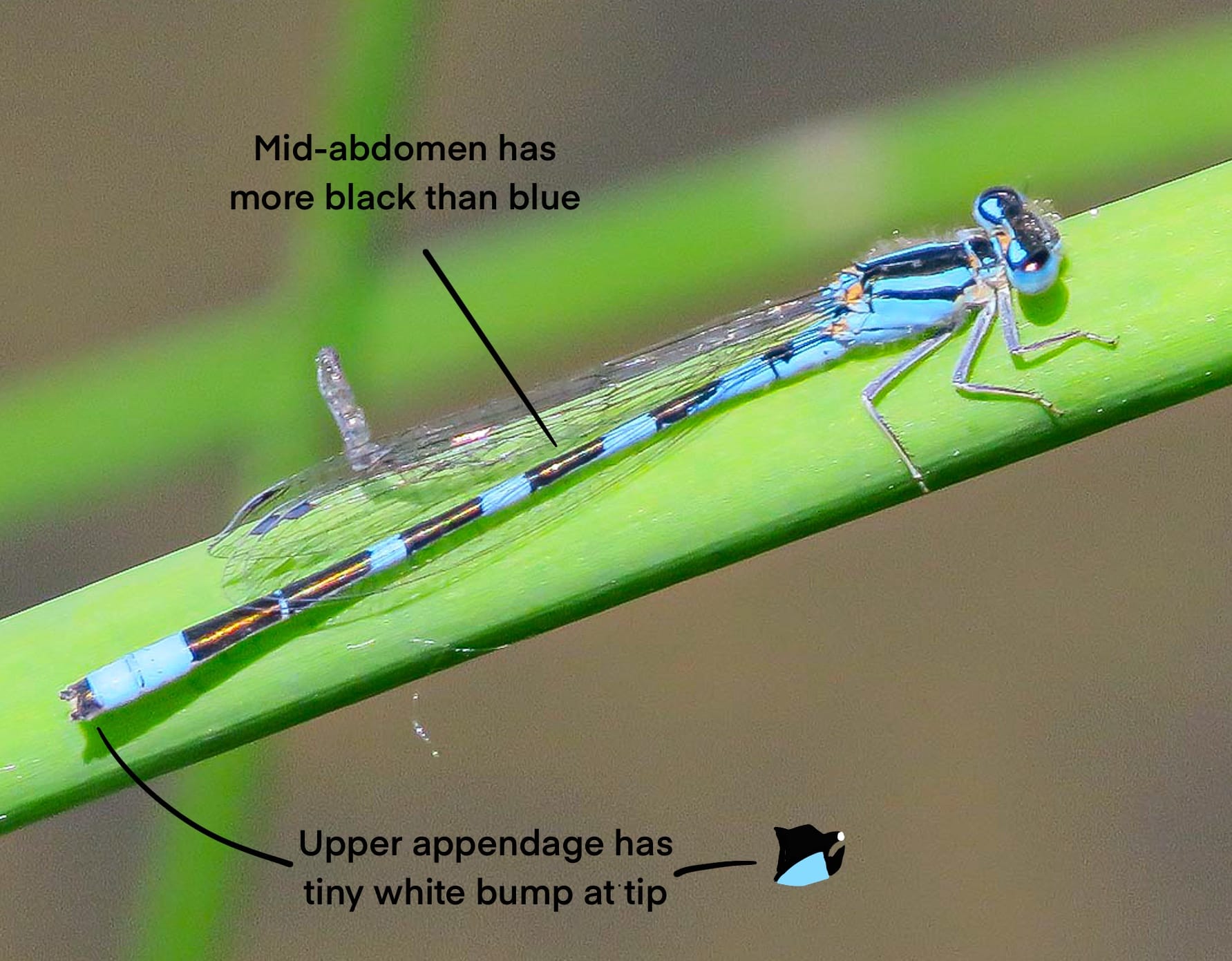
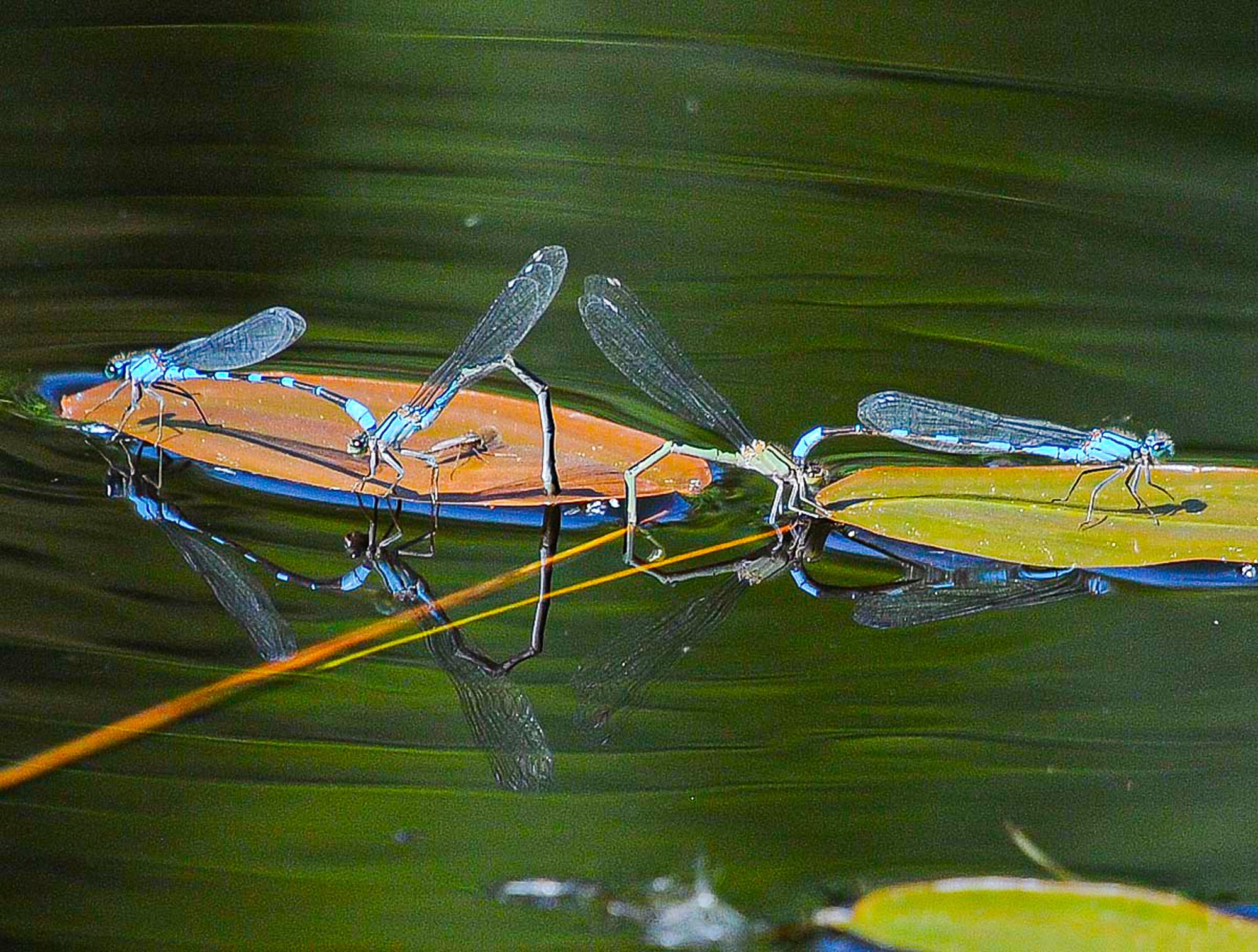
PACIFIC FORKTAIL Ischnura cervula
Commonly observed around the marshy edges of lakes, ponds, or slow streams up to 5800ft. Often the only damselfly found in the middle of dense cattail or bulrush stands.
Found March 20 to November 8, being the first damselfly or dragonfly to emerge in the spring.
Identification:
Thorax on male is black on top with four blue dots. Tail has a black tip.
Females occur in different forms.
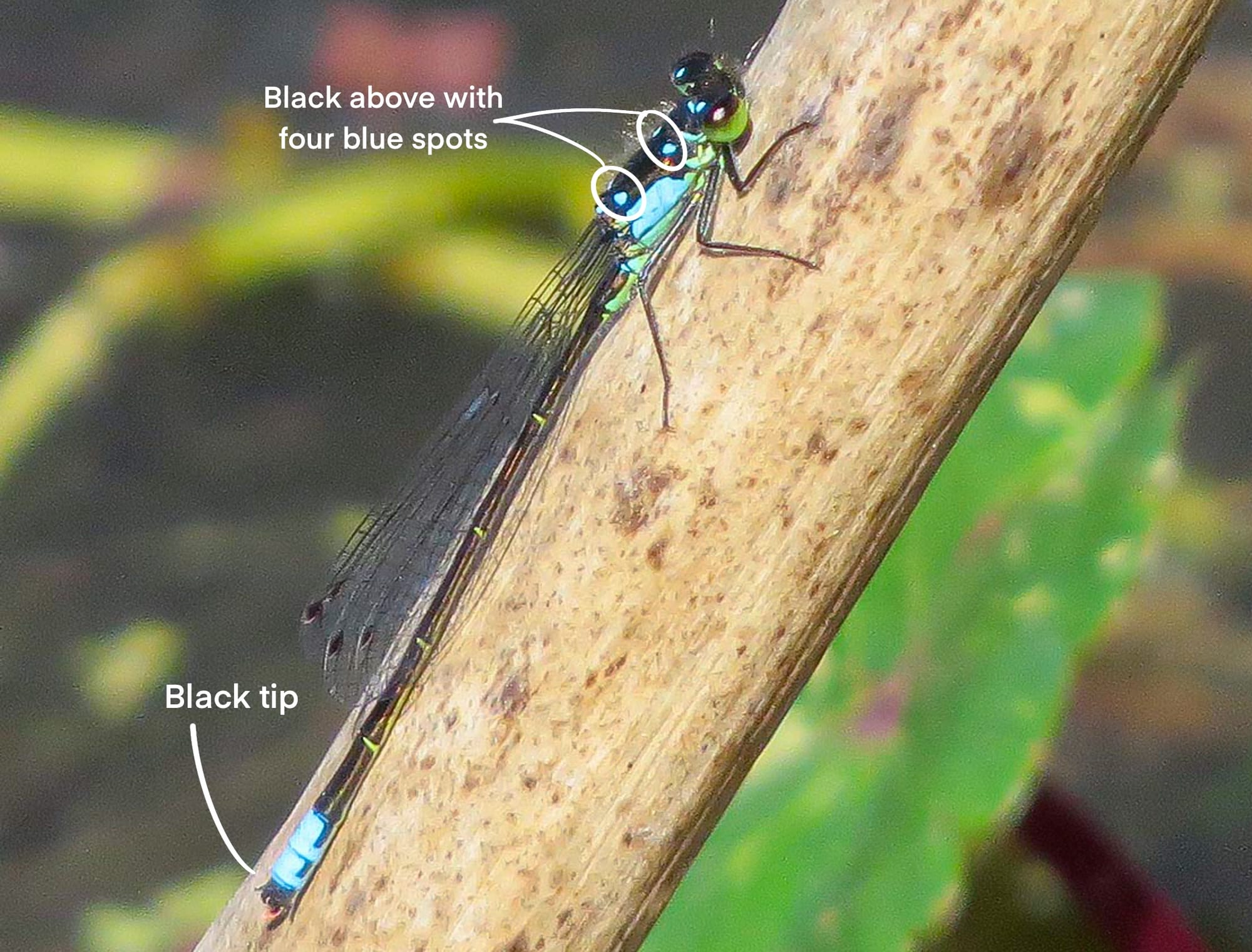
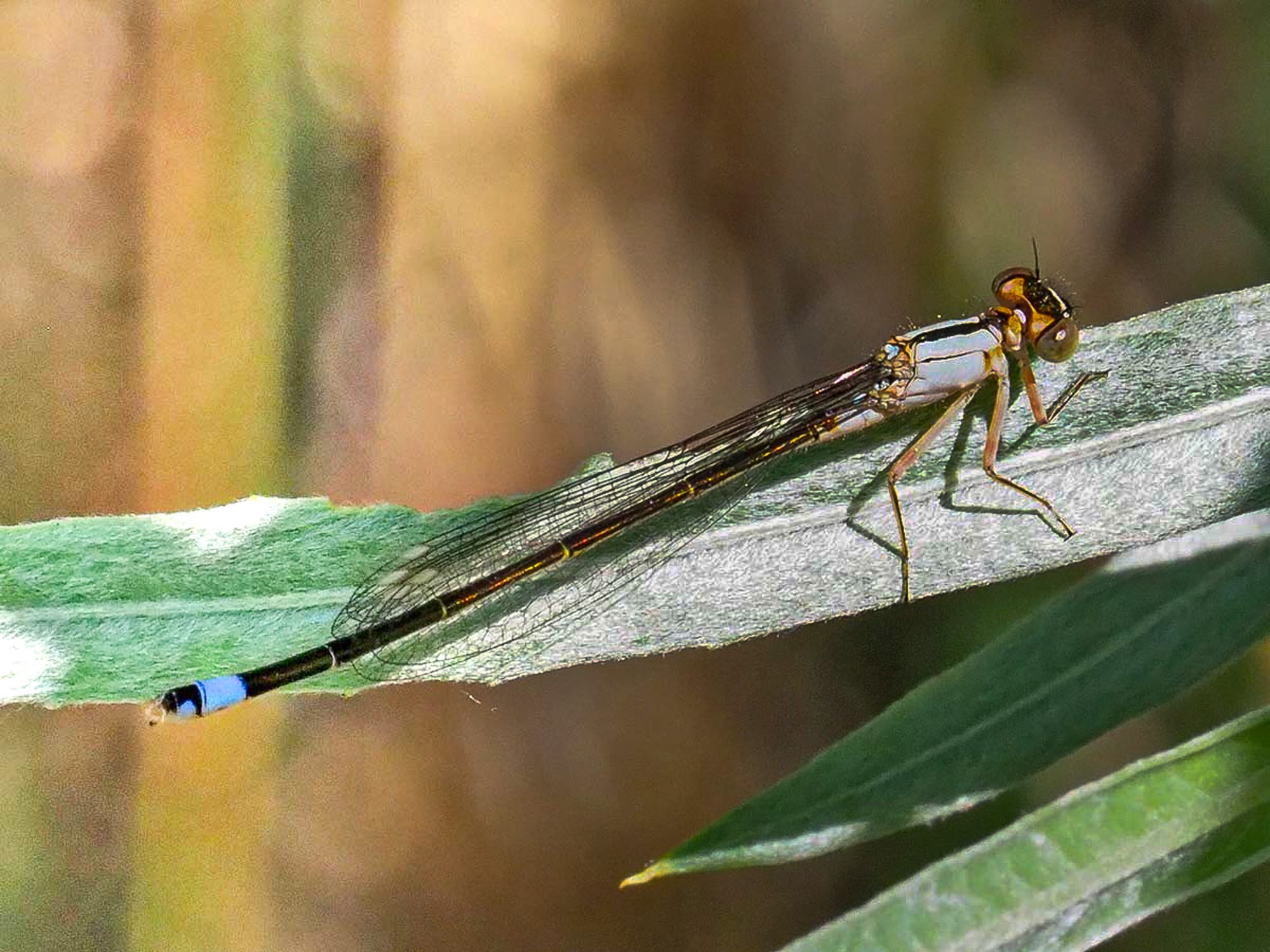
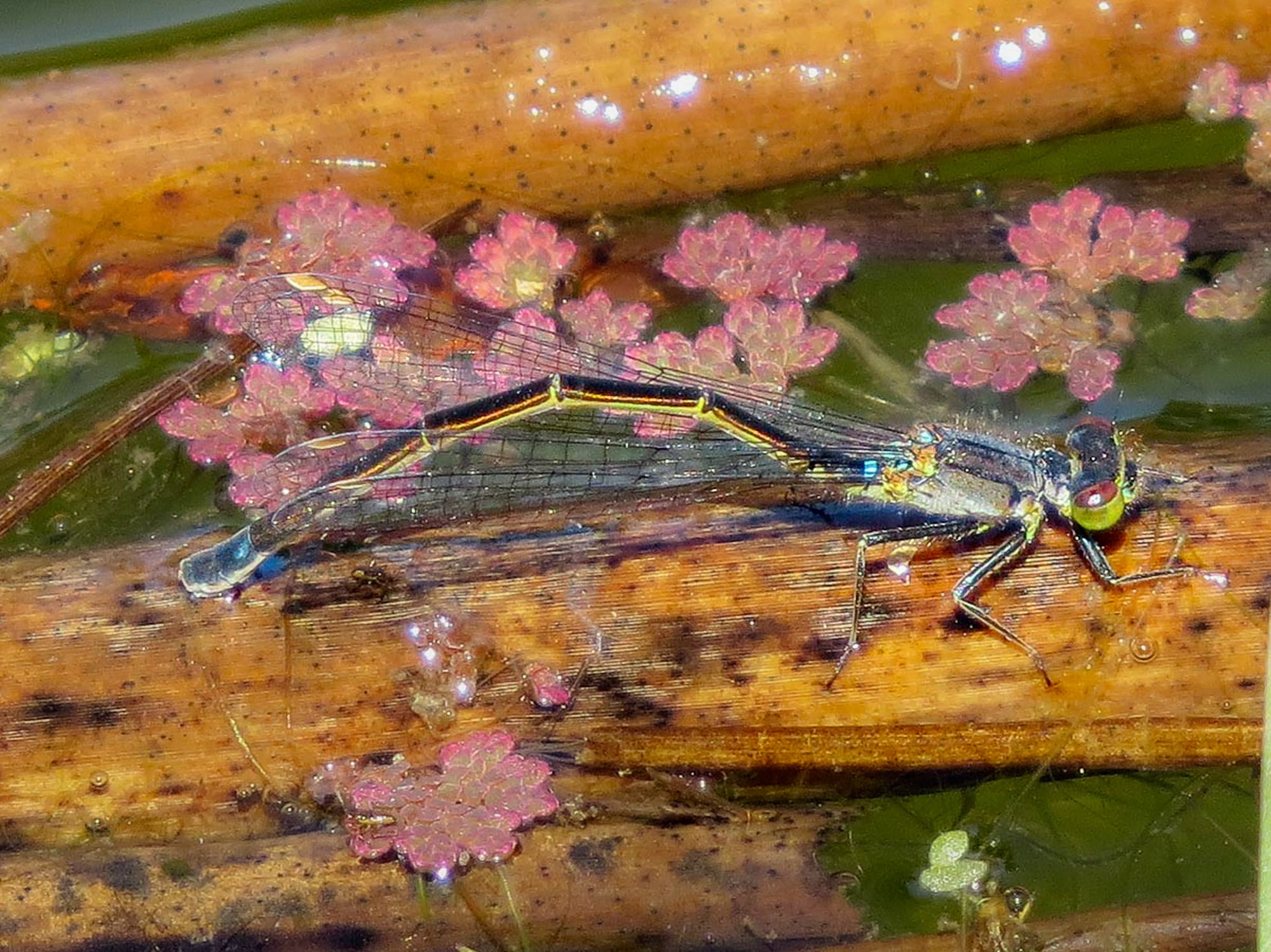
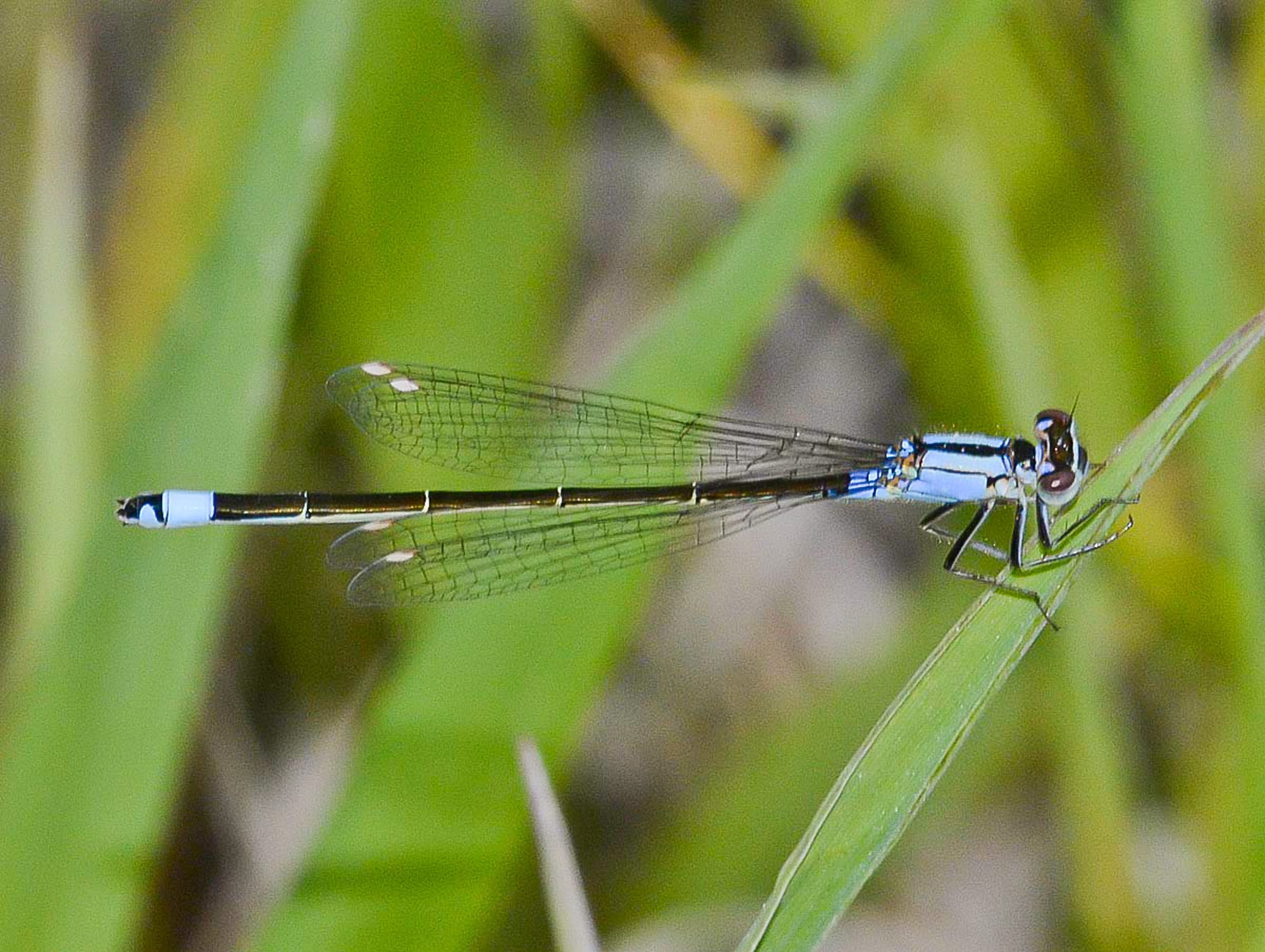
WESTERN FORKTAIL Ischnura perparva
Common in same areas as Pacific forktail but more likely to be found around slow streams. Females may be abundant as they lay eggs on floating vegetation, males remain typically remain in dense vegetation. One our smallest damselflies.
Found April 14 to October 26.
Identification:
Male thorax has pale green to blue-green stripes. Abdominal segments have pale rings.
Females are black and orange when young, entirely washed with blue-gray pruinosity when mature.
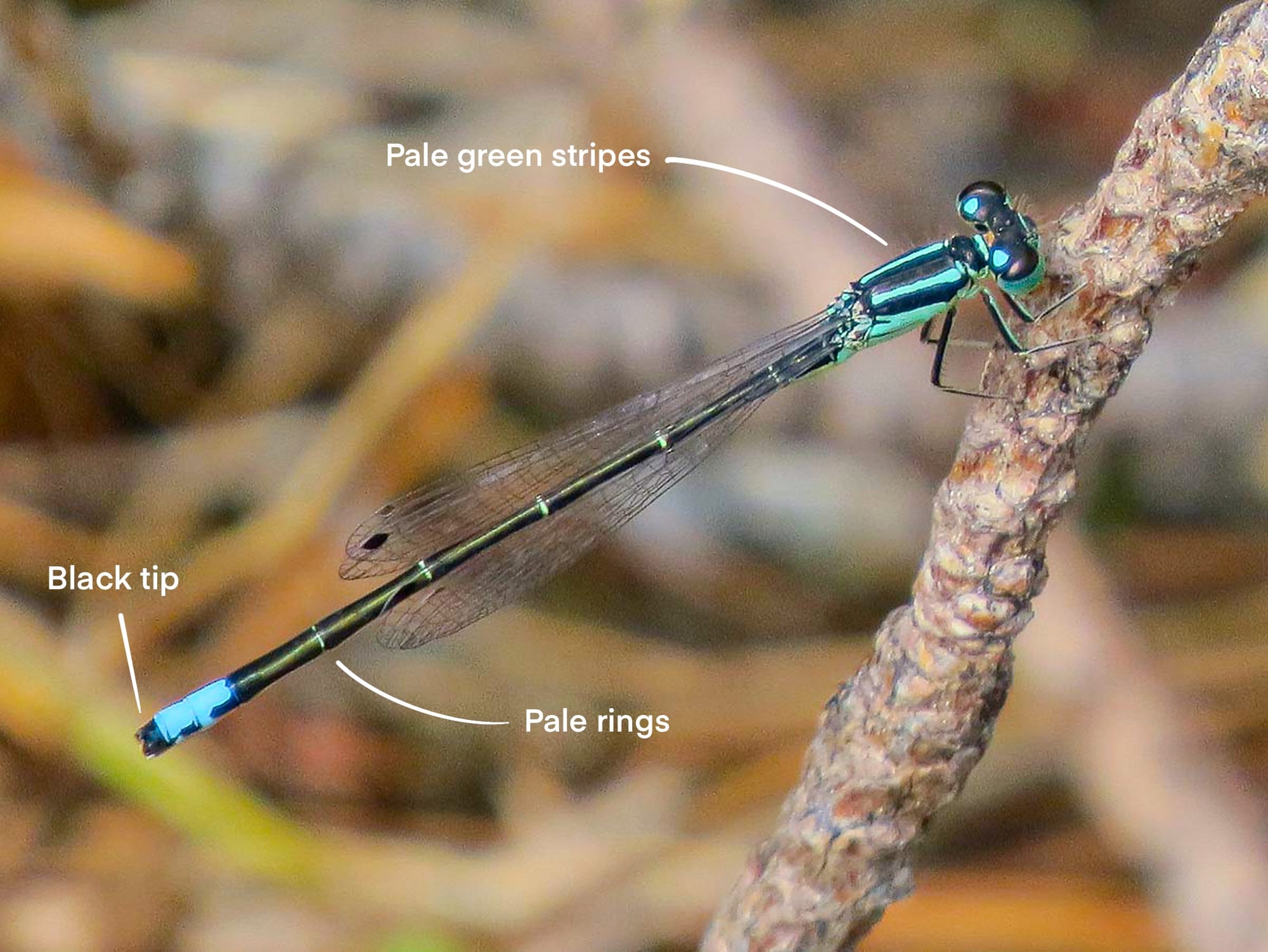
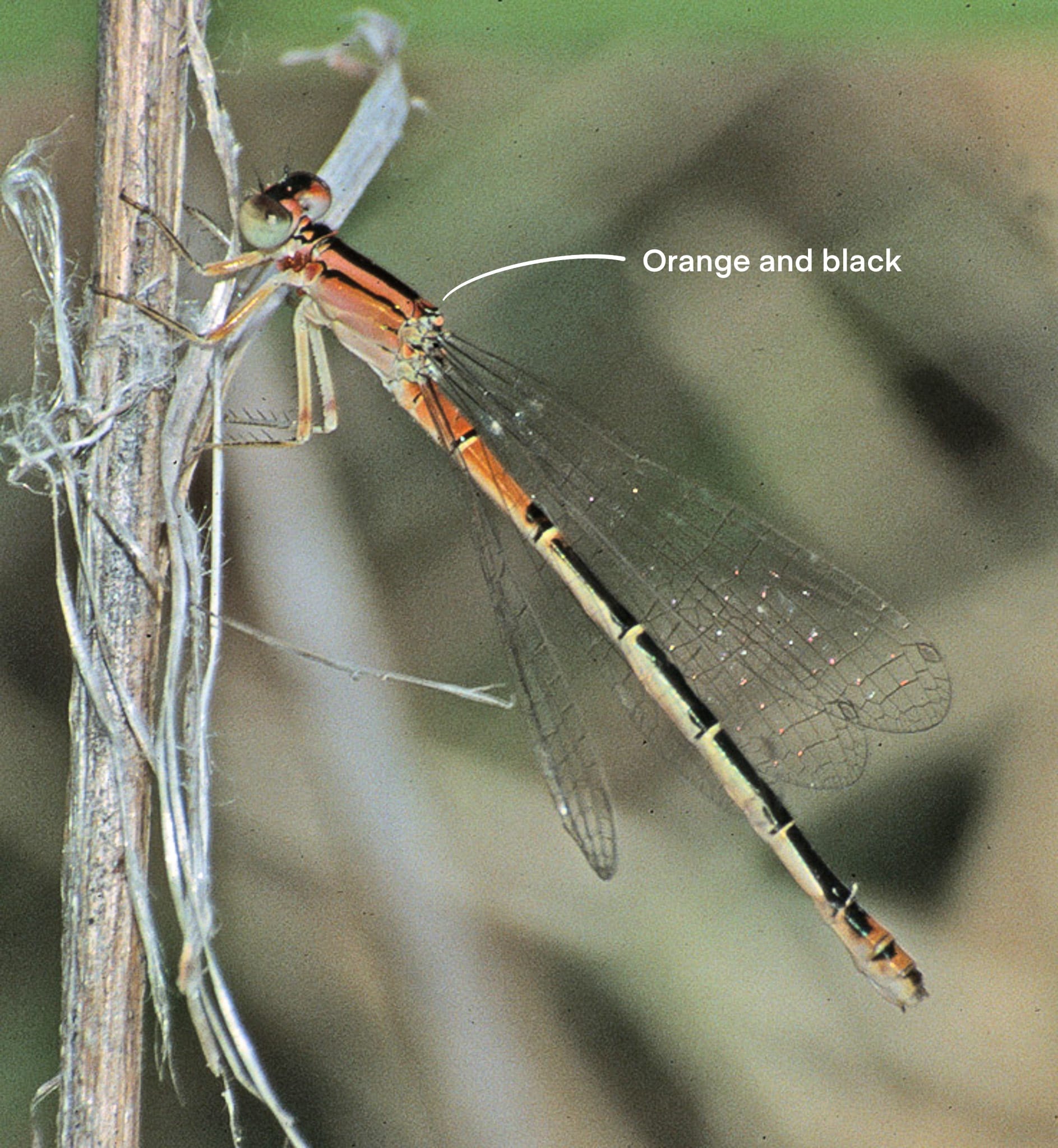
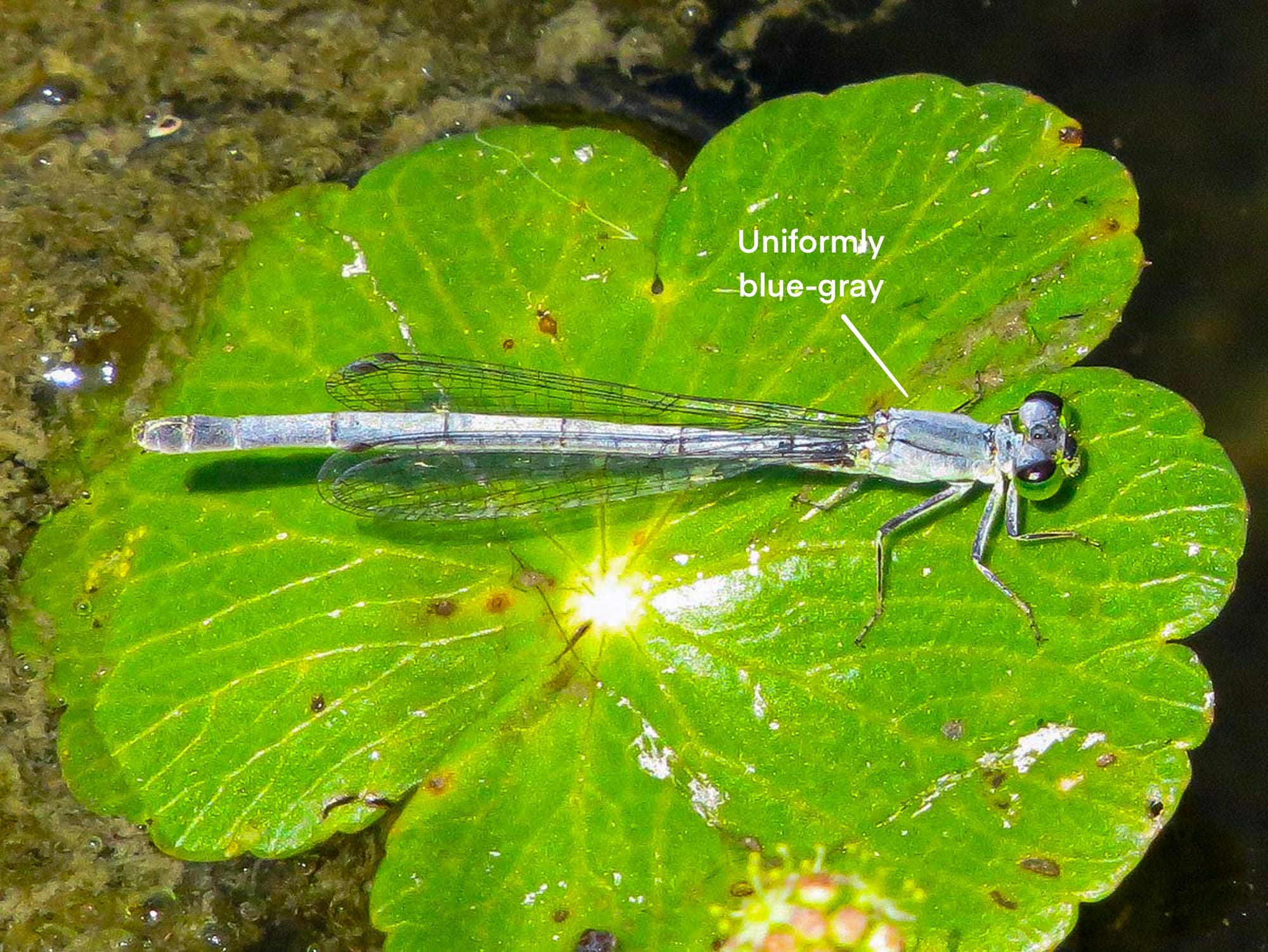
SEDGE SPRITE Nehalennia irene
Occurs around sedgy marshes in foothills and lower mountains from 2000-4550 feet. Remains in dense vegetation and doesn't fly very often so can be hard to find, plus they are only an inch long.
Found from June 17 to September 20.
Identification:
Both sexes are similar, with top of thorax being metallic green and bottom being light blue. Tip of tail is blue.
